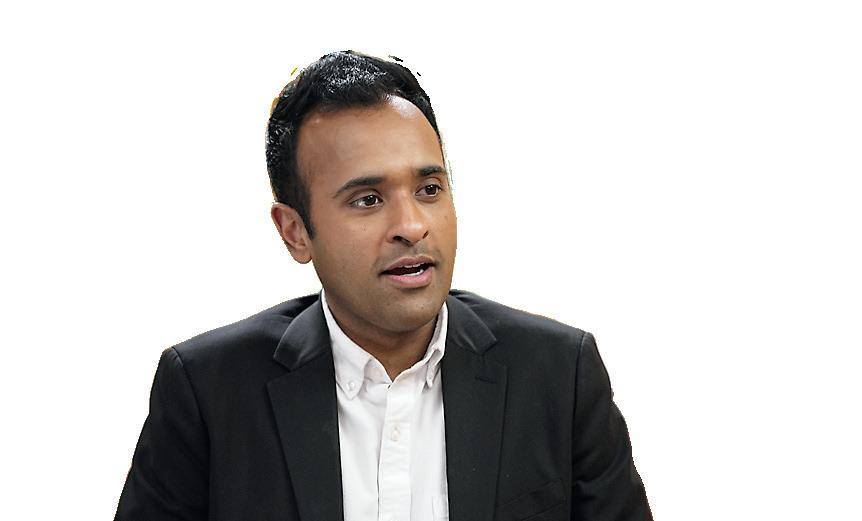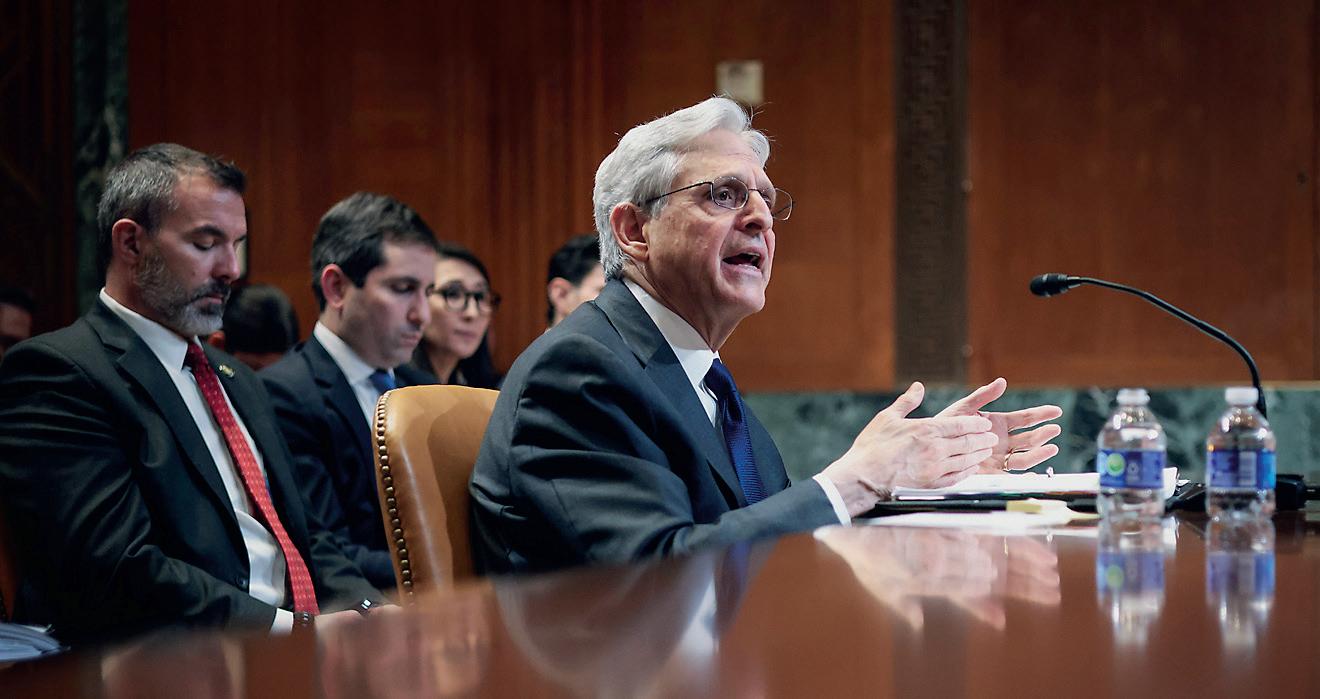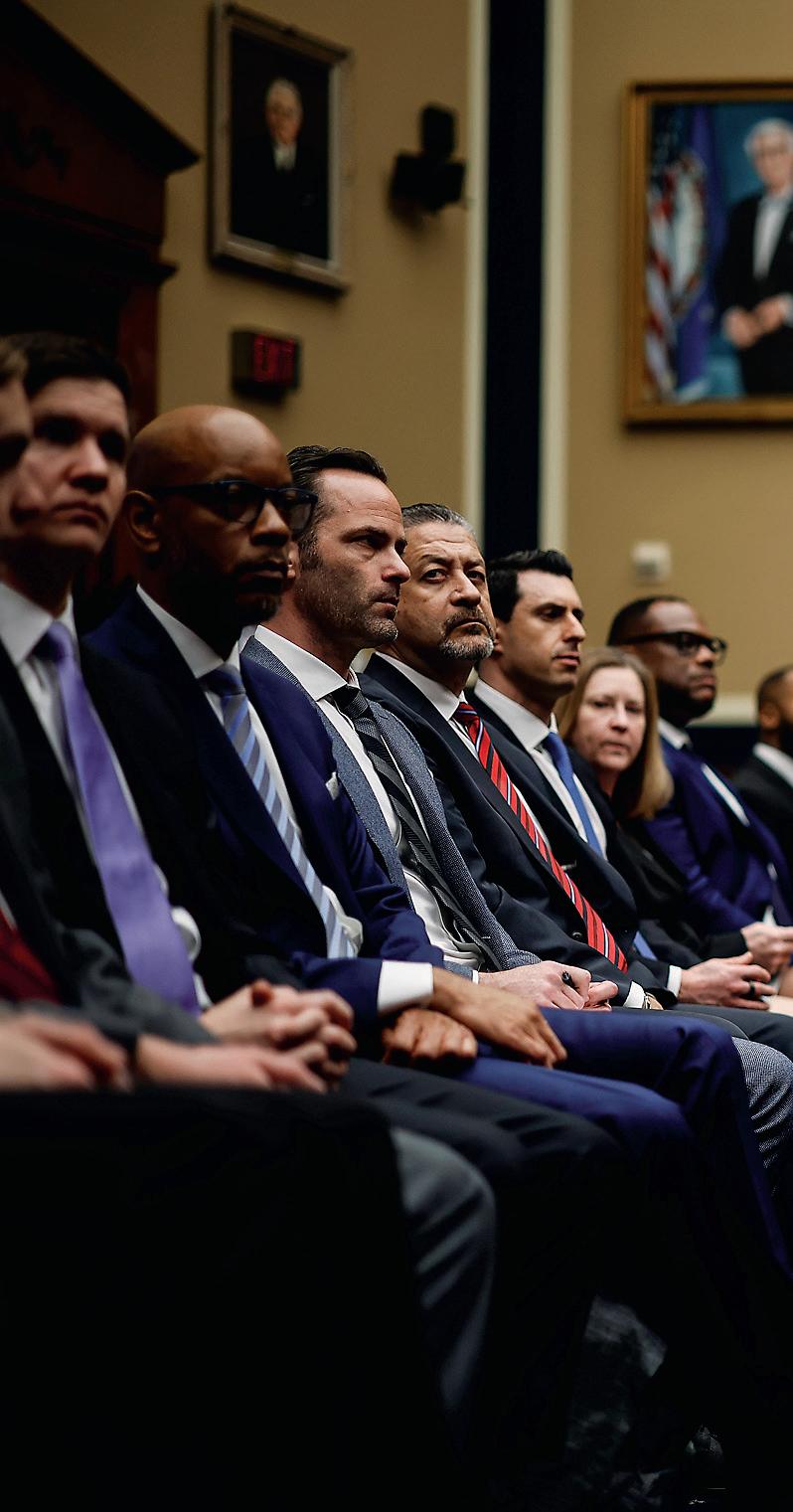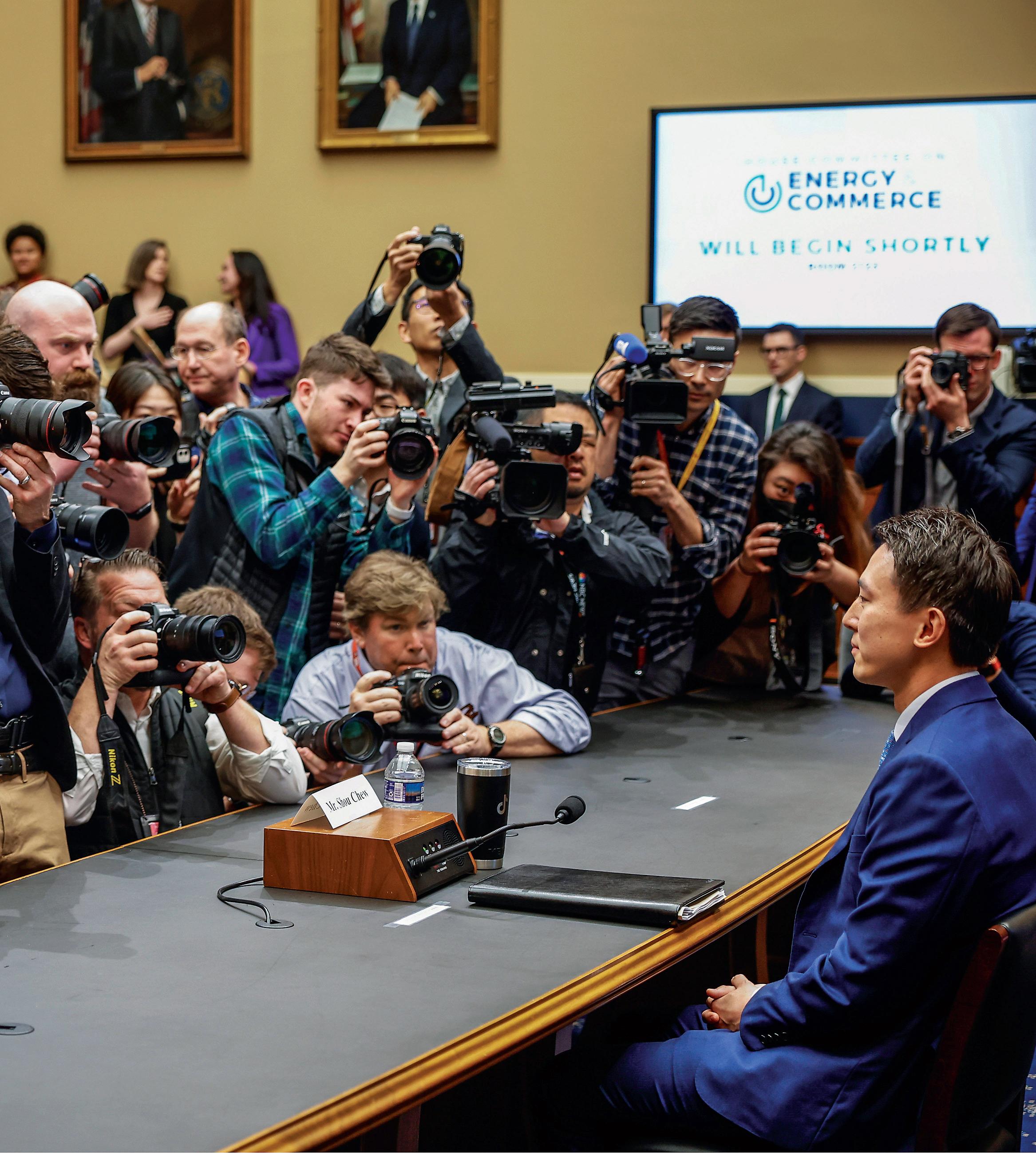DECIMATING THE SAFARI

CHINESE, SOUTH AFRICAN ‘MAFIAS’
WIPING OUT WILDLIFE: REPORT
BY DARREN TAYLOR

CHINESE, SOUTH AFRICAN ‘MAFIAS’
WIPING OUT WILDLIFE: REPORT
BY DARREN TAYLORbig safari animals in south africa are being wiped out by organized crime groups from South Africa and China, aided by corrupt officials.
Between 2011 and 2020, Kruger National Park’s white rhinoceros population fell by 75 percent, to about 2,607 from 10,600.
The animals known as the “big five”— the African buffalo, African elephant, rhino, leopard, and lion—are most at risk as China’s black market fuels poaching. Ivory from elephant tusks fetches high prices on black markets, while rhino horn and lion bones are in high demand in China.
A new report suggests that 40 percent of Kruger park rangers are corrupt. Others turn a blind eye out of fear.
The report cites a ranger who received threats to his family from the syndicate: “You work in the park, your wife is alone at home with the kids, and this is where the kids go to school. You make the choice.”
The park’s head ranger, who’s received numerous death threats, told Epoch Insight’s Darren Taylor that it’s “impossible” to enter Kruger to kill animals “without cooperation from inside the reserve.”
Read this week’s cover story to find out more about how organized crime groups from South Africa and China—in collaboration with corrupt wildlife officials—are decimating the population of big game animals in one of the world’s premier game reserves.
 JASPER FAKKERT EDITOR-IN-CHIEF
JASPER FAKKERT EDITOR-IN-CHIEF
CHANNALY PHILIPP
LIFE & TRADITION,
TRAVEL EDITORCHRISY TRUDEAU
MIND & BODY EDITOR
CRYSTAL SHI
HOME, FOOD EDITOR
SHARON KILARSKI
ARTS & CULTURE EDITOR
BILL LINDSEY LUXURY EDITOR
FEI MENG, BIBA KAYEWICH ILLUSTRATORS
SHANSHAN HU
PRODUCTION
CONTACT US
THE EPOCH TIMES ASSOCIATION INC. 229 W.28TH ST., FL.7 NEW YORK, NY 10001
SUBSCRIPTIONS
READEPOCHINSIGHT.COM
GENERAL INQUIRIES, LETTERS TO THE EDITOR HELP.THEEPOCHTIMES.COM

ADVERTISING
ADVERTISENOW@EPOCHTIMES.COM
(USPS21-800)IS PUBLISHED WEEKLY BY THE EPOCH MEDIA GROUP, 9550 FLAIR DR. SUITE 411, EL MONTE, CA 91731-2922. PERIODICAL POSTAGE PAID AT EL MONTE, CA, AND ADDITIONAL MAILING OFFICES. POSTMASTER: SEND ADDRESS CHANGES TO THE EPOCH TIMES, 229 W. 28TH STREET, FLOOR 5, NEW YORK, NY 10001.
Jasper Fakkert Editor-in-chief
Some of the world’s most majestic animals are slowly being wiped out by black market demands and corruption.
TONY KARUMBA/AFP VIA GETTY IMAGES
18 | Wind Resistance
A congressional resolution is calling to halt offshore projects, pending a review.
36 | Bank Failures
Precious metal sales are booming as banks are busting.
53 | ‘Human Shields’
Illegal immigrants are the perfect cover for drug cartels, former Border Patrol chief says.
54 | ‘Forever Chemicals’
Chemicals in everyday products are worsening America’s fertility crisis.
56 | CDC Data
Autism is increasing and now affects 1 in 36 children.
58 | Government Control
Should those in power dictate what we eat and drink?
59 | National Security
Lawmakers are debating whether to ban TikTok or force its sale.
60 | Federal Budget
Without entitlement reform, deficits will expand inexorably.

61 | Government–Corporate Collusion
An investigation exposes a revolving door between the DOJ and Big Tech.
14 | School Reading
Parents question South Carolina program that’s only available for non-white students.
22 |
Uyghur Persecution
A new report accuses UNESCO of covering for the CCP’s atrocities.
26 | Transgenderism
California schools are secretly transitioning kids, emails reveal.
38 | Kruger National Park Chinese and South African ‘mafias’ are decimating safari wildlife, a report says.
42 |
Wrongful Conviction?
Advocates fight to free a man they say was wrongly sentenced to life.
62 | Bank Failures
The SVB collapse is a direct consequence of loose monetary policy.
63 | Financial Crisis
Depositor panic has gripped every regional and smaller bank.
64 | Cultural Breakdown
Heather Mac Donald discusses meritocracy versus diversity.
68 | Quitters Can Win
Realizing a goal can’t be achieved allows you to succeed at another.
70 | Boats & Beaches
An estate with frontage on the ocean and the Intracoastal Waterway.
72 | Tropical Island
Bora Bora is a magical, mystical island that simply must be visited.
75 | For Wine Lovers
Virginia has more than 300 wineries, making it a wine-lover’s paradise.
76 | The Perfect Pooch
Some suggestions for those looking for a family pet.
79 | Touring on Wheels
A selection of touring “bikes” that make every ride an adventure.
83 | Banking Behavior
A few etiquette tips to practice on your next trip to the bank.

 PEOPLE FLOAT IN BOATS ON CHIDORIGAFUCHI, one of the moats around the Imperial Palace, enjoying the scenery of cherry blossoms in full bloom, in Tokyo on March 27. Chidorigafuchi is home to a 700-meterlong tunnel of cherry trees.
PHOTO BY KAZUHIRO NOGI/AFP VIA GETTY IMAGES
PEOPLE FLOAT IN BOATS ON CHIDORIGAFUCHI, one of the moats around the Imperial Palace, enjoying the scenery of cherry blossoms in full bloom, in Tokyo on March 27. Chidorigafuchi is home to a 700-meterlong tunnel of cherry trees.
PHOTO BY KAZUHIRO NOGI/AFP VIA GETTY IMAGES

A Uyghur woman parks her scooter next to a propaganda painting showing soldiers meeting with a Uyghur family, near Kashgar, Xinjiang region, China, on June 2, 2019.

The beleaguered ex-CEO of FTX bribed Chinese officials with $40 million in cryptocurrency, according to the DOJ. 52
‘Human Shields’
Illegal immigrants are the perfect “cover” for drug cartels’ operations, according to a former U.S. Border Patrol chief. 53
More children in the United States than ever before have autism, CDC data suggest. 56

COVID-19 vaccine damages in the United States in 2022 indicated that more than 26 million people were injured at a cost of nearly $150 billion to the economy, a report from Phinance Technologies estimates.

1,400 TONS
Three barges, one carrying 1,400 tons of toxic methanol, broke free of their tugging vessel and got stuck in the Ohio River near Louisville, Kentucky, on March 29.
700 SIGNALS
The Centers for Disease Control and Prevention found more than 700 signals that the vaccines could cause adverse events in May 2022, according to files obtained by The Epoch Times.
67% Prosecutors under U.S. Attorney for the District of Columbia Matthew Graves declined to prosecute 67 percent of people arrested by police in 2021, including 53 percent of felony cases.
1,100 EXPERTS Twitter CEO Elon Musk has joined more than 1,100 artificial intelligence experts and industry executives in signing an open letter calling on all AI labs to “immediately pause” the training of systems more powerful than Chat GPT-4 for at least six months.
“We protect our banks, green pieces of paper sitting in the bank account, more effectively than we protect our kids in schools.”
“We are in a conflict with a nation state that doesn’t just seek to replace us, they seek to reorient the world.”
Sen. Marco Rubio (R-Fla.), on the conflict between the United States and China
VivekRamaswamy, 2024 Republican presidential candidate, after a mass shooting at a Christian elementary school in Tennessee
MORE THAN A QUARTER , or 25.1 percent, of house hunters in the United States were seeking to relocate to a new metropolitan area in February, according to real estate company Redfin.

ATTORNEY GENERAL MERRICK GARLAND defended the FBI’s usage of the Foreign Intelligence Surveillance Act (FISA), saying that the surveillance apparatus is critical to “fight the Chinese.”
Garland made the comments during a hearing by the House Appropriations Subcommittee on Commerce, Justice, Science, and Related Agencies. He came to Capitol Hill to discuss the Department of Justice side of President Joe Biden’s proposed budget.

During the hearing, Garland defended the FBI’s use of FISA Section 702, a post-9/11 section of U.S. Code that is controversial for its wide-ranging application in surveilling U.S. citizens. A court-ordered report found that the FBI had used that section of U.S. law to illegally spy on more than 3.3 million Americans without a warrant, including an unnamed sitting member of Congress.
Garland said that FISA Section 702, despite abuses, provides “an extraordinarily large proportion of the intel we get.”
“It’s a tool we need to fight the Chinese particularly,” he said.
THE SENATE VOTED to repeal a Biden administration regulation of U.S. waters and wetlands on a vote of 53–43.
In early March, the Republican-controlled House approved the resolution 227–198, in accordance with the Congressional Review Act, which allows Congress to strike down regulations within 60 days of passage. While President Joe Biden is expected to veto the resolution, it’s unlikely that Republicans can achieve a two-thirds majority in both houses in Congress to override a veto.
That’s an increase from 22.9 percent in 2022 and about 18 percent prior to the pandemic. The latest number is a record high, indicating a housing market shift toward relocation, which may be attributed to elevated mortgage rates, high property prices, and decades-high inflation combined with economic uncertainty. Americans are looking to move to areas with cheaper homes amid a rise in remote work.
Miami; Phoenix; Las Vegas; Sacramento, California, and other Sun Belt options were among the top destinations for house hunters.
THE UNITED STATES is in “terrible shape” financially and is “flying blind in mountains of debt” that will cause future generations to “reap the whirlwind of an irreparable economic disaster” unless immediate action is taken, according to some witnesses and members of the House Budget Committee.
Witnesses who testified at the hearing on the country’s financial outlook uniformly recommended cutting the size of the federal budget deficit and reducing the national debt, which has reached $31.4 trillion, the largest dollar amount in history and the largest percentage of the nation’s gross domestic product since World War II.
THE RISK OF SUDDEN CARDIAC death in young women more than tripled following an AstraZeneca COVID-19 shot, according to a study using England’s official data.
US–CHINA
THE HOUSE OF REPRESENTATIVES overwhelmingly approved a measure to punish communist China for its forced organ harvesting from prisoners of conscience, marking the first nonsymbolic legislative measure in the United States to counter the atrocity.

The Stop Forced Organ Harvesting Act of 2023 (H.R. 1154), which passed on a vote of 413–2, would sanction anyone involved in the act and require annual government reporting on such activities taking place in foreign countries. Sens. Tom Cotton (R-Ark.) and Chris Coons (D-Del.) were among more than a dozen lawmakers leading the measure’s companion version in the Senate.
The bill, led by Rep. Chris Smith (R-N.J.), includes stiff penalties for those found to be involved in forced organ harvesting: a civil penalty of up to $250,000 and a criminal penalty of up to $1 million and 20 years in prison.
CHINA SPENT $240 BILLION to bail out 22 participant countries in its Belt and Road Initiative (BRI) between 2008 and 2021, a study shows.
The bailout is more than 20 percent of total International Monetary Fund (IMF) lending over the past decade, according to the study published by AidData, a research lab at the College of William & Mary. The research indicates an accelerating trend, with $185 billion, or nearly 80 percent, of the total extended from 2016 to 2021.
China’s lending is opaque, more expensive at an average 5 percent interest rate versus the IMF’s 2 percent, and offered almost exclusively to BRI countries. BRI is the Chinese Communist Party’s multibillion-dollar global infrastructure development strategy.
Vahé Nafilyan, senior statistician at the Office for National Statistics, said researchers found “receiving a first dose of a non-mRNA vaccine was associated with an increased risk of cardiac death in young women.”
THE SENATE HAS VOTED , 66–30, to repeal the 1991 and 2002 Iraq War authorizations.
The first Authorization of Use of Military Force (AUMF) allowed the United States to enter the Gulf War, during which then-Iraqi leader Saddam Hussein’s forces were driven out of Kuwait. The second AUMF allowed the U.S. military to go into Iraq following reports that Hussein had weapons of mass destruction.

















 By Jackson Elliott
By Jackson Elliott
fter spending months of late nights helping her son as he struggled to learn to read, one South Carolina mom was thrilled to discover that her child’s school had a special program to help students who were falling behind.
But after inquiring about the program, she was shocked to learn that he wouldn’t qualify for the tutoring, she said. The reason: He’s white.
The book club, designed to provide extra help in reading at St. James Elementary School (SJES) in Myrtle Beach, welcomed black children only, a district spokeswoman confirmed.

“How does that make sense?” asked Laura, who requested to not be fully identified in order to protect her son.
“We are supposed to be equal and have the same opportunities,” Laura told The Epoch Times. “It just seems very unfair.”
A spokeswoman for Horry County Schools confirmed that the reading program at the school focused on teaching African American students.
“The goal of the club was to support them academically so they could achieve at the same level as students of other subgroups that were meeting reading growth targets,” Lisa Bourcier, the district’s director of strategic communications, wrote in an email to The Epoch Times.
“Each student was assigned a mentor, and the students met with the media specialist twice a month during their independent reading time to read culturally reflective texts.”
The program was active for seven months during the 2020–2021 school year, Bourcier said in her email.
“St. James Elementary School administration is not aware of any parent who requested that his/her child participate in the book club and was denied participation,” she said.
She added that Horry County schools hold “data team meetings to address the academic needs of all students.”
Laura’s son likes to help others, meet new people, and play with Pokémon and superhero toys, she said. But school is difficult because he struggles to read, likely because of his attention deficit hyperactivity disorder.
She received little help from the school as she watched her son fall behind, she said. Finally, a doctor diagnosed the reason for his struggle.
She questions why the school didn’t recognize the problem, “even though they have the resources to diagnose him,” she said.
Laura bought a special learning program for
them to tackle together during the summer, trying to “teach him at home what they should be teaching him at school,” she said.
“He never was pulled out to get extra attention for reading, even when he was struggling,” she said.
There were others who didn’t qualify for the school’s reading help because they didn’t fit the right racial profile.
In 2021, there were 21 students in third grade and 19 in fourth grade who were behind in reading, according to state statistics.
Yet only 17 students—all of them African American—were allowed to participate in the reading club, according to documents obtained through a public records request by the local Moms for Liberty chairman.
According to documents obtained by David Warner of Moms for Liberty, the 2020–2021 school year was “the only year that a book club was specifically designed to address the African American subgroup.”
The club was part of SJES’s new initiatives to boost diversity, equity, and inclusion (DEI), the documents state.
“We don’t stand for that,” Warner told The Epoch Times. “We want it to be all students that get help, not just African American students.”
The book club program did seem successful. Of the 17 students who participated, 11 boosted their proficiency, school documents show.
Warner said he first learned of the book club’s existence after hearing SJES had received a national award.

“Gender, race, and ability levels are used to create balanced classrooms with equitable opportunities to grow and learn, to promote cultural awareness, and to foster appreciation for diversity among students and staff,” the school’s application for the award read.
The application also praised its “change project” to increase African American reading scores.
School principal Felisa McDavid conducted an “equity audit” from 2020 to 2021, records showed.
The Epoch Times contacted McDavid but received no response.
After the COVID-19 pandemic, SJES committed on its website “to keep educational equity front and center by providing assistance, resources, and partnerships.”
The commitment to equity included response teams to work with “family needs,” attempts to “address discrimination, biases, and student conduct,” increasing “awareness of the diversity among families,” support for “social-emotional needs,” and other initiatives.
The audit discovered that SJES’s student body was 90 percent white, 4 percent black, 5 percent Hispanic, and 2 percent Asian. The teaching staff was 98 percent white.

After the audit, McDavid set out to make changes. Gym classes began to include African dance and a multicultural mural was painted on the walls, McDavid said in YouTube videos. And the reading club for African American students was put into place.
“What they did was segregation,” Warner said. “They literally segregated children for a reading program.”
Training for teachers at the school also focused on equity.
Teachers attended Equity in Education conferences put on by the Center for the Education and Equity of African American Students at the University of South Carolina, the Blue Ribbon Award application notes.
Facilitating the training was University of South Carolina professor Gloria Boutte. She describes
“We want it to be all students that get help, not just African American students.”
David Warner, chair, Horry County chapter, Moms for Liberty
schools as places of “physical, symbolic, linguistic, curricular/instructional, and systemic suffering” for African American children in her book “We Be Lovin’ Black Children: Learning to be Literate About the African Diaspora.”
In the book, she describes the “Whiteness of curriculum” as “violence,” and writes that, in school, African American children undergo “spirit murders.”
McDavid committed to hiring teachers at the school based on race.
“My targeted equity commitment is to recruiting and retaining a diverse teaching force in my school,” she said in a video posted to YouTube.
In the video, McDavid cites studies that found that minority students learn better and obey better when taught by teachers of the same race. Having the “rich experience and expertise” of African American teachers would benefit all students, she says in the video.
In a video, McDavid notes that 59 percent of Af-
(Left) As parents grow more aware of their childrens’ experience in public schools, they are increasingly switching to private schools or homeschooling. (Above) A Moms for Liberty booth at an event in Tampa, Fla.,

rican American students failed state expectations for learning English.
In another YouTube video, McDavid shares that her school’s teachers reported that African American students weren’t getting enough educational support from parents. She blames the feedback on “a bias” and vowed to eliminate the complaint.
“We are working to dispel that bias through more culturally responsive unit planning and professional development,” she said.
AN ESTIMATED 1.4 million students left public schools for private schools, charter schools, or homeschooling during the COVID19 pandemic.
When questioned, the school said the book club was just a club. Documents provided to The Epoch Times describe the program as an “intervention.”
“Intervention should never be based off of a child’s race, but their educational need,” Warner said.
When he asked how the reading program worked, the school stopped giving him details, he said. It was unclear whether the students met with teachers after school or were pulled from class during the school day.

“They’re not willing to talk about what happened,” Warner said.
Knowing the school has provided racially segregated programs that exclude her son has prompted Laura to plan for private school next year. It destroyed her trust, she said.
“I just don’t feel like they have my son’s best interests at heart,” she said.
An estimated 1.4 million students left public schools for private schools, charter schools, or homeschooling during the COVID-19 pandemic.
growing chorus of interest groups is calling for a pause in offshore wind activities to allow further assessment of the sector’s effects on the marine ecosystem.
Rep. Jeff Van Drew (R-N.J.) introduced a congressional resolution on March 21 to halt work on East Coast offshore wind projects until there can be investigations into their possible effect on marine mammals.
Fishing groups and local residents have filed five lawsuits against wind projects that have been proposed or are under construction along the Atlantic seaboard.

A leading body for the U.S. Pacific fishing industry is urging the federal government to call off its proposed auction for offshore wind off the Oregon coast.
And the United States’ largest lobbying group for Native Americans recently called for a halt to all offshore wind scoping and permitting.
Wind energy is a key component of the Biden administration’s climate agenda. Its goal is to generate 30 gigawatts of energy from fixed-bottom offshore wind farms by 2030, which it claims could power 10 million homes, and 15 gigawatts from floating offshore wind infrastructure by 2035, potentially providing power to 5 million homes.
An uptick in marine mammal deaths along the north Atlantic has been cited as reason for concern.
Since December 2022, 29 whales have died on the East Coast, and 14 dead dolphins have washed ashore in New Jersey in the past month, including eight on March 21.
Van Drew believes that the survey and construction work associated with wind farms, which can reportedly damage dolphin and whale hearing, may be to blame.
The National Oceanic and Atmospheric Administration (NOAA) has said its marine mammal stranding network hasn’t linked any of the whale deaths to offshore wind technology.
Van Drew said the NOAA and the Bureau of Ocean Energy Management (BOEM) have ap-
proved “these massive construction projects right in the middle of whale feeding and breeding grounds, as well as migration routes.”
BOEM has already leased 2.3 million acres and plans to lease another 1.7 million to install an estimated 3,500 turbines on the Atlantic coast.
“We are not even in the construction stage of these industrial wind turbine grids, yet we are already witnessing a highly unusual mortality rate of these intelligent marine animals,” he told The Epoch Times.
“We need a moratorium on all offshore wind projects before this gets worse, and I have introduced a resolution calling on Congress to do just that.”
House Resolution 239 states that the Atlantic offshore wind leases represent an industrialization of the oceans that hasn’t been thoroughly evaluated and asks Congress to declare an “immediate moratorium on development” until it can “conduct investigations to determine [its] true impacts.”
“Lease areas sit along known migration routes and foraging areas of North Atlantic right whales, humpback whales, and economically important commercial and recreational fish species,” it added, noting that cables will require dredging along hundreds of miles of ocean floor.
Rep. Andy Harris (R-Md.) supports Van Drew’s resolution.
“Since BOEM began authorizing testing for offshore wind project developments, we have witnessed an uptick in whale deaths,” including one recent whale death on Assateague Island in Maryland, Harris told The Epoch Times in an email.
“We need to take the time to gather proper scientific data, act in full transparency, and not rely upon platitudes for these projects, their construction, and the impact they may have upon our environment.”
Agency officials have since said an initial necropsy indicates that the whale death on Assateague Island is consistent with a vessel strike, after observing blunt force trauma on the nearly 34-foot female.
Wind turbines on the shore of Atlantic City, N.J. Rep. Jeff Van Drew (R-N.J.) believes that the construction of wind farms may be to blame for the death of marine mammals.
According to Sarah Wilkin, NOAA’s Marine Mammal Health and Stranding Response Program coordinator, there has been an “unusual ongoing mortality event since 2016 that is specific to the humpback whales,” and there has been a similar increase in deaths of endangered North Atlantic right whales. Researchers are unsure of the cause of the spike in mortalities.
Although no deaths have been linked to the offshore wind farms, according to NOAA, a better understanding of the potential effects of the wind projects planned off southern New England will be crucial to protecting the endangered right whale, which is increasingly inhabiting the same waters.
“Increased noise from wind turbine construction and operations and vessels could ... directly impact important whale behaviors and interfere with the detection of critical acoustic cues. These types of impacts may also be associated with physiological stress and could affect the whales’ use of the region,” an agency news release states.
“The presence of wind turbine foundations may impact oceanographic and atmospheric conditions including potential changes in ocean stratification. This might alter the formation of plankton aggregations and thus foraging opportunities for right whales.”
The Pacific Fishery Management Council is urging BOEM to rescind the current Oregon lease areas designated for floating offshore wind energy development in the Pacific.
The council passed a resolution at its March 10 meeting recommending that BOEM restart the process of identifying suitable areas for installing offshore wind turbines to account for the needs of the fishing industry.
BOEM announced in April 2022 that it would lease two areas for offshore wind development off the Oregon coast. In the coming year, it plans to auction 1.15 million acres starting 12 miles offshore along the south-central and southern Oregon coast.
Acknowledging the risk to marine life—including that of whales becoming tangled in the moorings and cables associated with floating wind platforms—federal agencies have commissioned more than a dozen studies of the environmental, economic, and social impact of large-scale development along the Pacific Coast.
But the Pacific coast leasing areas were selected before the studies were complete.
The council recommended that BOEM start the siting process over again using a spatial mapping tool focused on identifying areas suitable for wind energy development that won’t negatively affect West Coast fisheries.
Meanwhile, Native American tribes claim they have been left out of the process.
BOEM HAS already leased 2.3 million acres and plans to lease another 1.7 million to install an estimated 3,500 turbines on the Atlantic coast.
The nation’s oldest association of American Indian and Native Alaskan tribes has called for a moratorium on offshore wind development along U.S. coasts, insisting that the Biden administration do a better job protecting tribal interests.
The National Council of American Indians issued a resolution on Feb. 24 asserting “shared tribal jurisdictional authority over and tribal management of offshore renewable energy activities, aimed at empowering Native communities through socio-economic benefits such as job opportunities, revenue sharing, and support for tribal energy development projects.”
It urged the Department of the Interior and BOEM to “halt all scoping and permitting for offshore wind projects until completion of a comprehensive and transparent procedure adequately protecting tribal environmental and sovereign interests is developed and implemented.”

New report accuses UNESCO of covering for CCP as it oppresses Uyghur culture
 An ethnic Uyghur woman and child walk by a closed Islamic school in the old town of Kashgar, Xinjiang region, China, on July 1, 2017.
PHOTO BY KEVIN FRAYER/GETTY IMAGES
An ethnic Uyghur woman and child walk by a closed Islamic school in the old town of Kashgar, Xinjiang region, China, on July 1, 2017.
PHOTO BY KEVIN FRAYER/GETTY IMAGES
 BY ALEX NEWMAN
BY ALEX NEWMAN
The u n . agency dealing with education and culture is under fire as the heritage system is made “complicit” in ongoing atrocities perpetrated by the Chinese Communist Party (CCP) against Uyghurs and their culture.
According to a new report by the Washington-based Uyghur Human Rights Project (UHRP), the CCP’s systematic actions against Uyghur culture and heritage are part of a broader campaign of “genocide” in the region of Western China known as Xinjiang.
Amid all of that, the U.N. Educational, Scientific, and Cultural Organization (UNESCO), charged by the international community with helping to protect cultural heritage around the world, is remaining silent and even providing cover for the CCP, according to the report.
“In China, heritage is used as a soft tool of governance to control and manage history, and to steer people’s memories, sense of place, and identities in particular ways,” the report concludes. “When the management of heritage is used in tandem with the hard modes of governance currently in play in the Uyghur region—ones that states and international bodies have designated a form of genocide—then the heritage system is complicit in those acts of genocide.”
The UHRP and its allies around the world have asked the United Nations to speak out.
“Where is UNESCO when the Chinese government is literally destroying the identity and culture of Uyghurs?” Peter Irwin, senior program officer with UHRP, asked.
Irwin, who provided support and guidance to the authors of the report, told The Epoch Times he thought UNESCO was refusing to speak out because of the funding it receives from China.
“They should be publicly speaking about it,” he said. “They understand the place they’re in. It’s a challenging environment for them. But they should be speaking out.”
Citing statements from the U.S. government and other sources, Irwin suggested that the cultural heritage being destroyed in China documented in the report actually represents the destruction of a people.
“Effectively, this is genocide,” he said. “If this were any other government in the world, UNESCO would be talking about it.” UNESCO told The Epoch Times that it would be up to its member states to determine what course of action the organization takes.
The new report, released last month and titled “The Complicity of Heritage: Cultural Heritage and Genocide in the Uyghur Region,” details a systematic campaign of cultural destruction by the CCP of the largely Islamic minority.
Everything that gives the group its unique cultural identity—tradition, music, dance, religion, language, poetry, and more—is being targeted by the CCP as UNESCO stands by in silence, the researchers found.
These CCP attacks on Uyghur cultural heritage include the destruction of mosques and other religious sites and restrictions on the use of regional languages, according to the report. Hundreds or even thousands of intellectual and
cultural leaders have been imprisoned, the UHRP added. By UNESCO’s own standards, these actions amount to “strategic cultural cleansing,” the report states. Such behavior is often “inseparable” from—or even a precursor to—genocide, according to experts cited in the document.
“As acknowledged by the International Criminal Court, acts of dispossession and destruction of cultural heritage are often the precursor to acts of genocide,” University of London professor Rachel Harris, who co-authored the report, said.
“Attacks on cultural heritage, from sacred architecture to community practices and customs, are inseparable from direct physical attacks on human beings. They are a form of cultural warfare aimed at the elimination of a people and their identity.”
Governments and human rights organizations, including some U.N. agencies and officials, have also documented widespread CCP crimes against the Uyghur population over the past decade.
These atrocities include mass detainment in reeducation camps, torture, rape, forced labor, mass surveillance, forced sterilization, and separation of families.
Estimates suggest that more than a million Uyghurs and people of other minorities are currently detained in

concentration camps across the region.
In 2021, the U.S. State Department even concluded that the CCP’s actions in the region amount to “genocide” and “crimes against humanity.” Numerous other Western governments have issued similar condemnations.
The CCP, however, claims that its actions are reasonable and necessary to deal with terrorism and extremism, denouncing those who speak out for allegedly interfering in China’s internal affairs.
Despite everything the international community knows, UNESCO continues to acknowledge the Chinese regime as the “protector” of Uyghur, Kazakh, and Kyrgyz heritage in the region.
The U.N. agency lists a number of key items of cultural heritage in the region, while the report focuses on five in particular.
According to the report, the CCP is co-opting Uyghur heritage and using it to promote “new and revisionist understandings of history” in a way that “contributes directly to the wider project of cultural erasure.”
According to scholars cited in the report, the CCP effort to purge and replace Uyghur history with a version approved by
The Artux City Vocational Skills Education Training Service Center, a reeducation camp where members of Muslim ethnic minorities are detained, located north of Kashgar, Xinjiang region, China, on June 2, 2019.

the CCP has resulted in prison and even death sentences for those who propagate “incorrect” views of the region’s history.
The regime’s goal is a version of history that centers on a “pluralistic-unified” Chinese nation, and it will go to great lengths, such as destroying or hijacking cultural heritage, to achieve that vision, the report states. Countless families and communities have been forced off their ancestral lands in the process.
Many Uyghurs and outside scholars refer to the region as East Turkistan, though the CCP is seeking to promote the narrative that the peoples of the area have always been an inseparable part of China.
“This report was a response to the lack of action from UNESCO,” Irwin, the UHRP official who worked on the document, said. “We wanted to document the violations and even attacks on UNESCO-listed heritage.
“The government itself—if you have an understanding of the CCP—they are not fond of differences. They want everybody to look the same, speak the same language. They think that reduces conflict. That policy has existed for decades, but it really got much more intense starting 10 years ago when Xi Jinping came to power.”
Considering its mandate to preserve cultural heritage, UNESCO has a “responsibility” to act, Irwin continued in a phone interview. Yet it’s “totally failing to ensure that China protects this priceless intangible cultural heritage,” he said.
“The secretary-general hasn’t said a word on these Uyghur issues, either.”
What is happening is, in fact, a genocide, Irwin said, adding that the ongoing destruction of mosques and targeting of religious and cultural leaders is only one element.
“This is all part of a larger context of abuses and genocide,” he said, noting that no other government in the world could get away with what the CCP is doing and not be condemned by UNESCO and other U.N. agencies.
Among other recommendations, the UHRP called for senior U.N. officials to urge UNESCO to provide a more effective response to the abuses.
The organization also encouraged U.N. member states to initiate actions under international agreements on culture that the CCP has signed.
Irwin suggested that U.S. policymakers be more involved in the debates at the U.N. rather than allowing the CCP to dominate.
Currently, the U.S. government is not a member of UNESCO. Following in the footsteps of President Ronald Reagan, President Donald Trump ordered a U.S. withdrawal from the organization, citing anti-Semitism, extremism, and corruption among its leadership and in its decisions.
“I don’t think UNESCO is fixable,” former U.S. Assistant Secretary of State for International Organization Affairs
Kevin Moley told The Epoch Times, noting that the agency’s policymaking had “largely been taken over by the CCP and its allies.”
President Joe Biden’s administration and some of its allies in Congress were hoping to get the U.S. government involved again, The Epoch Times reported in late 2021.
But under federal laws signed by Presidents George Bush and Bill Clinton, the U.S. government is also banned from funding the U.N. agency over its decision to admit the “State of Palestine” as a member.
The Epoch Times reported in 2020 that multiple senior officials and analysts have expressed grave concerns about what they describe as a CCP “takeover” of the U.N. and its agencies, with Moley referring to it as “the greatest existential threat to our republic since our founding.”
But Irwin and the UHRP said that the U.S. government can still help curb the cultural destruction taking place in Xinjiang.

“Given that the U.S. government has described what is happening as genocide and crimes against humanity, there is an obligation for policymakers to follow up,” he said, calling for an “atrocity prevention task force” or some similar body to get involved.
“There should be a lot more visible public advocacy,” he said, adding that other governments should also speak out. But there are complicating factors.
Irwin argued that one of the CCP’s goals was to “pacify” the region to facilitate its “Belt and Road” trade initiative, which aims to connect China to the rest of Eurasia and beyond.
That same Belt and Road plan, along with the opportunities it brings for other governments in the region and for spreading the CCP’s influence, is among the reasons why governments—including nearby Islamic governments such as Pakistan’s—have been so reluctant to speak out about Xinjiang.
“They made it very clear that they have chosen the side of China despite what’s happening to the Islamic population in China,” Irwin said. “Trade and money are the overriding factors.”
Expert Peter Irwin believes UNESCO refuses to speak out about China’s human rights issues due to the funding it receives from the regime.
Many of those governments have their own human rights issues, too, he added.
Irwin said there would be more work in the next few months to get state parties to the World Heritage Convention to speak up.
“UNESCO as a body is limited if they don’t get support from governments,” he continued, noting that UNESCO is not unique in failing, as member states have “an obligation” to use the mechanisms at their disposal to address this.
A spokesman for UNESCO deflected blame, pointing to member states of the international body as the decision-makers.
“UNESCO wishes to underline the importance attached to inclusion and respect for communities in the management of inscribed sites and elements, as is clearly set forth in the texts of its conventions,” the spokesman said, pointing to the World Heritage Convention and the Intangible Heritage Convention that govern these issues internationally.
“The practice and procedure is that when UNESCO receives precise and credible information about a specific element inscribed on a UNESCO list, this information is shared with the concerned member states, so as to bring both the information shared by civil society and the member states’ response—if any—to the attention of the appropriate committee.” The spokesman said it was UNESCO policy not to
have comments attributed to a particular individual.
“It is then for member states of the respective committees to assess the situation and take appropriate [action].”
It isn’t the first time the CCP has come under fire for these issues. In August 2022, then-U.N. High Commissioner for Human Rights Michelle Bachelet released a report finding that CCP abuses against Uyghurs may constitute “crimes against humanity.”

Although governments on the U.N. Human Rights Council failed to approve a proposal to debate the issue, numerous prominent human rights organizations urged Western governments to pursue accountability for the alleged crimes perpetrated by the CCP.
Uyghurs and Muslims are among many groups that experts and human-rights monitors say are persecuted by the CCP. Other victims include practitioners of Falun Gong, Christians, and Tibetans.
The CCP’s foreign ministry didn’t respond by press time to requests by The Epoch Times for comment.
In a press conference last month, however, CCP Foreign Ministry spokesman Wang Wenbin dismissed reports of human rights violations in Xinjiang.
“The so-called ‘violation’ or ‘repression’ of human rights is the lie of the century propagated by anti-China forces and has long been debunked by facts,” he was quoted as saying in news reports.
Aparental rights group in Orange County, California, claims that 23 students—eight of them elementary school age—began social gender transitioning at a local school district without informed parental consent from January 2020 to October 2022.

The group, California Alliance for Education, obtained hundreds of pages of emails and documents from the Newport-Mesa Unified School District, which oversees pre-K through grade 12 schools for Newport Beach and Costa Mesa.
A parental rights advocate involved with the alliance who goes by the pseudonym Kim Davis for fear of retaliation told The Epoch Times that in all 23 cases, parents were either not informed about the initiation of their child’s “gender support plan,” known as a GSP, or were told and didn’t consent.
“All of these ‘gender support’ plans were offered to students without any knowledge of the parents. The student is
then asked if they want their parents included in the meeting, or to know about it. So, it’s the student’s decision,” Davis said. “It’s possible some of the parents of the 23 children may have been informed later, but the emails show the process of social transition was initiated without their involvement.”
Social transitioning means changing a student’s name, pronouns, and their email address to reflect their new nonbinary or transgender identity.
The emails, obtained by The Epoch Times, reveal the following incidents:
• The district created plans to place mental health counselors in elementary schools to initiate GSPs with students without parental consent, and an elementary school principal and a director of student services discussed adding these counselors to assist with GSPs. In the email, the principal instructs a counselor to “build connection” with an elementary student and ask about preferred pronouns without first obtaining parental consent.

• A local LGBT activist pushed for the social transition of an elementary student against a parent’s wishes.
• Elementary school students were socially transitioned without parental consent. In one case, a mom didn’t want her child to transition, and the school moved forward with the social transition of the child anyway.
• A district student services director celebrated more than 500 mental health check-ins by counselors underway at district elementary schools.
• The district made room assignments for sleepover camps, such as sixth grade Science Camp, based on gender identity instead of biological sex.
• A high school student’s parents didn’t attend a “gender support” meeting because the student didn’t want the parents to know.
The public records also show that an activity called Gender and Sexuality Galaxies produced by the progressive organization Action Canada for Sexual Health and Rights was sent to district counselors and psychologists, and one of the middle school mental health providers has pushed back against the teaching materials.
The colorful diagrams, which show 10 gender identities and 12 sexual orientation choices, with “infinite possibilities” of gender expression, were distributed to the counselors and psychologists on Trans Visibility Day on March 31, 2021, Davis said.
The document tells instructors to ask students to “imagine themselves as existing within the Gender Galaxy
and the Sexuality Galaxy” and “imagine themselves as a space traveler” as they “write or draw their own story of planetary and space exploration.”
Annette Franco, a public relations officer for the school district, said in an email to The Epoch Times that the district wasn’t aware of the 23 cases documented by California Alliance for Education.

The district, she said, is required by antidiscrimination and privacy laws, including Assembly Bill (AB) 1266, to maintain confidentiality regarding students’ “gender support” plans and preferred pronouns unless the students give staff permission to inform their parents or guardians.
“We have an obligation as public
school employees to put our personal beliefs aside and abide by all applicable laws that govern public school districts,” Franco said.
She cited district policy, which requires notification of parents and students annually about the possibility of transgender students participating in sex-segregated school programs and activities with students of the opposite gender.
“The notice shall inform students and parents/guardians that the district will not typically notify them of individual instances of transgender students participating in a program or activity,” the policy states.
The California Department of Education has provided guidance to teachers and counselors advising them to not inform parents or guardians when a student asks for a social transition unless the student wants to tell them.
But Davis contends that these mandates aren’t the law.
AB 1266, a 2014 law known as the School Success and Opportunity Act, states that students must be permitted to participate in sex-segregated school programs and activities, and use facilities consistent with their gender identity without regard to their biological sex.
“That’s all the law says. It says nothing about socially transitioning kids without parental consent,” she said. “So, it’s not the law. The California Department of Education guidelines appear likely to be unlawful in that respect.”
Davis cited provisions under the California Education codes and the Protection of Pupils Rights Amendment Act, a federal law that states that parents have a right to know and direct the upbringing of their children.
The guidelines suggest that unless a student wants to tell his or her parents, teachers must call a student by the child’s preferred pronouns at school but use the student’s natural or birth pronouns when they communicate with the child’s parents or face reprimand and possible criminal charges for harassment.
In a parent-teacher conference, for example, teachers are expected to refer to transgender students by their birth names, deceiving parents about childrens’ social transitions in the classroom, Davis said.
Some teachers and administrative
The district is required by California law to maintain confidentiality regarding students’ ‘gender support’ plans and preferred pronouns unless the students give staff permission to inform their parents.
staff fear being fired for violating state mandates, because they are presented in a way that creates a fear of legal recourse if a teacher informs parents without the child’s consent or fails to use the student’s preferred pronouns, for example, Davis said.

“My heart absolutely breaks for all the amazing teachers who are put in such uncomfortable situations with these guidelines,” she said. “When you really break it down, what these guidelines are instructing teachers to do is lie to the parents. The deception to parents is such a huge issue, and it puts these teachers in such a moral conundrum.”
Davis said mental health “checkins” on students are another violation of parental rights.
“The district has just spent an enormous amount of resources on this army of mental health counselors who are coming into the classrooms and initiating ‘checkins’ with students all without parental consent,” she said.
Parents aren’t aware of what the counselors are speaking to their children about, but these counselors are the ones initiating the GSPs, Davis said.
“This is actually pulling kids out of class to check in with them about their mental health, and so there is no survey that parents can opt out of, there is no transparency over when and how these check-ins are occurring,” she said. “It’s alarming.”
Haley Jenkins, a parent who pulled her children out of school in the district, told The Epoch Times parents have heard about GSPs and the gender and sexualities charts but felt the district wasn’t being transparent about the issues, so they filed a public records act request.
“We’ve been hearing rumors from different teachers and students that social transitioning was taking place at the district,” Jenkins said. “As a parent, I believe all parents or guardians deserve to know when they send their child to school that they’re going to come back home as the same child. And that is not the case.”
Jenkins said the emails exchanged between school staff are “really concerning.”
“There’s a lot of parents that don’t even know what a ‘gender support’ plan is or how that works,” she said. “Basically, your rights as a parent are taken away. ... Every parent deserves to know if something serious like that is happening at school.”
Many parents don’t know, for example, that when they send their children to an elementary school overnight science camp, students of the opposite sex could be rooming and showering together, she said.
“As a parent, you deserve to know what is happening ... and if your child is not safe,” she said. “I don’t know that I feel comfortable sending my child to school when there’s a child of the opposite sex in the same locker room as them or same bathroom as them.”
The emails reveal that there is some pushback from teachers over the policies, but the mental health counselors are affirming new gender identities of students without telling parents.
“They’re keeping a secret from you, and they’re working with the child instead of working with you to help the child,” she said. “Parents are in charge of their children, full stop—not the school, not the child. The parents are in charge.”
Jenkins pointed out that Newport Harbor High School has links on its website to resources for lawyers, doctors, and surgeons who are actively pushing “gender-affirming” care.
Until a few months ago, the high school had links to a meetand-greet event with the surgeons at the University of California–Irvine, and places to get chest binders, which, she said, are known to cause physical damage to children.
“It’s just really scary,” she said.
Meanwhile, Republicans have recently introduced state and federal legislation to defund states that allow the secret transitioning of minors at schools.
On March 15, U.S. Rep. Doug LaMalfa (R-Calif.) introduced HR 1585, a House of Representatives bill that would block funds for states that allow such transitioning. The bill would require states under Title II of the Elementary and Secondary Education Act of 1965 to implement a policy prohibiting the controversial practice.
Two days earlier, California assemblymen Bill Essayli (R-Riverside) and James Gallagher (R-Yuba City) introduced parental rights legislation, Assembly Bill 1314, that would require teachers, counselors, and other school staff to notify parents in writing within three days if they find a student is identifying as a gender other than what is stated on their birth certificate.
The proposed legislation would mean an end to the current controversial policy in California of letting children decide whether to keep their gender transitions secret from their parents.

AN AERIAL VIEW OF PEOPLE PROTESTING against the government’s controversial judicial overhaul bill, in Tel Aviv, Israel, on March 25. Israeli Prime Minister Benjamin Netanyahu said he’s postponing the process of passing the judicial overhaul in order to engage in dialogue with the opposition and reach an agreement on an acceptable framework.
 PHOTO BY AHMAD GHARABLI/AFP VIA GETTY IMAGES
IDEOLOGY
PHOTO BY AHMAD GHARABLI/AFP VIA GETTY IMAGES
IDEOLOGY
Public employees in Virginia’s Prince William County are being asked to disclose their gender identity and sexual orientation in a taxpayer-funded survey.
Yesli Vega, who represents the Coles District on the Board of County Supervisors, brought the online survey from the county’s Diversity, Equity, and Inclusion (DEI) Office to light in an email to her constituents on Feb. 26.
Within days, county DEI Director Maria Burgos deleted the survey, which local media reported has cost county taxpayers about $78,000,
from the public domain; however, the “Inclusion Survey” has since been reopened to all employees, Potomac Local News reported.
To ensure public awareness of the survey, Vega read an email she received from a county employee into the record at the March 14 Board of County Supervisors meeting.
After Vega received the email dated March 3, she asked permission to share it publicly. Permission was granted following a revision that removed any information that might expose the whistleblower’s identity.
“It is with both great sadness and anger that I received the email from
my employer leading me to a survey, which begins by asking me my gender identity, race, and sexual orientation,” the employee wrote in the March 8 revised email, adding that not only were the questions “patently offensive and extremely invasive,” but also providing answers was “mandatory” to move on to the next question.
Regarding the question of gender identity, the employee noted that an option of “prefer not to disclose” wasn’t offered.
“So while it is counter to my beliefs that anyone can have a gender other than male or female, one’s biological sex, I must put those closely held
 Then-Republican U.S. House nominee Yesli Vega speaks during a campaign rally attended by Virginia Gov. Glenn Youngkin in Stafford, Va., on Oct. 28, 2022.
PHOTO BY ALEX WONG/GETTY IMAGES
Then-Republican U.S. House nominee Yesli Vega speaks during a campaign rally attended by Virginia Gov. Glenn Youngkin in Stafford, Va., on Oct. 28, 2022.
PHOTO BY ALEX WONG/GETTY IMAGES
beliefs aside in order to participate,” the employee said.
The employee was most aggrieved by “Demographic question #4.”
“This is the most offensive, outrageous, and abhorrent question asked,” the employee said. “It is not my employer’s business nor place to ask me the gender of my sexual partner. Why is my employer asking me for details of what happens in the privacy of my home, particularly my bedroom? What is the likelihood that I could bring a subordinate employee into my office, sit them down and ask them this question, and not end up embroiled in both a civil lawsuit and an internal investigation for sexual harassment or worse, with the likely outcomes of termination and an award monetary damages to that employee?”
county oppose. They’re not for it.”
Recalling the saying, “A fish rots from the head down,” Vega said that’s the case with Burgos’s approach, in that she has been “pushing the Marxist framework in education” for some time.
$78,000 SURVEY
A SURVEY ASKING public employees in Virginia’s Prince William County to disclose their gender identity and sexual orientation has cost county taxpayers around $78,000.

“And when she’s OK with spending nearly $80,000 on a Monkey Survey funded by the taxpayers, I feel a duty and an obligation to let the taxpayers know what this office is continuing to do and where their tax dollars are going. We’re still seeing record-high inflation, people are living paycheck-to-paycheck, and we’re looking for another increase in taxes with this new [Biden administration] budget.
budget last year calling for its complete defunding and elimination.
Burgos is no stranger to controversy, nor to using public funds to push a controversial ideology.
In December 2020, Vega and three Republican colleagues walked out of a “Raising Awareness of Unconscious Bias to Foster Inclusivity and Equity” presentation by Burgos, shown during a joint meeting with the supervisors and School Board members. Supervisor Pete Candland said he found the lecture, which began by insinuating that board members held unconscious racial biases, to be “insulting.”
The employee also addressed the “optional” question at the end of the survey, which “specifically directs” employees to answer an “open-ended question” addressing the importance of “inclusion” in the “performance of the firm.”
“It escapes me how this survey was approved by County leadership and how they thought this line of questioning was appropriate or acceptable,” the anonymous employee concluded, adding a request that the survey be “permanently terminated” and to have any “further inappropriate DEI initiatives canceled.”
According to Vega, she and the anonymous employee aren’t the only ones distressed by this survey.
“Based on the constant reminders” that the DEI has had to send out trying to get people to complete the survey, “we assume that there was low participation,” Vega said.
“The community is clearly upset,” she added. “This is an office that, since it has been established, has done nothing but cause further division, and it is something that people here in this
“Now, this office is OK’ing $80,000 in funding for a creepy and intrusive survey and it is completely unacceptable. Burgos OK’d the survey, she was OK with the line of questioning and she OK’d sending it out to County employees.”
Vega, who has long been a vocal critic of the county’s DEI Office, introduced a
Before being hired in March 2021 to be Prince William County’s DEI Director, Burgos was supervisor of Global Learning and Culturally Responsive Instruction with Prince William County Public Schools and was appointed by the Virginia Department of Education to the “Culturally Relevant and Inclusive Education Practices Advisory Committee.”
While serving on the committee, Burgos participated in a webinar series on “Culturally Responsive Teaching,” in which she said critical race theory
(CRT) was the foundational basis for the teaching.
While the video was removed from YouTube following backlash from Vega and local parent groups, an archived version of the video still exists.
Shortly after Burgos’s hire, Vega released a draft of the DEI’s office’s “Equity and Inclusion Policy” to the public. The program would have mandated “Equity Teams” in every government department, agency, and office, with no opt-out clause or protection of employment if not participating.
A FOIA request for resident feedback on the policy showed that more than 80 percent of Prince William County’s residents opposed the program’s proposed Marxist objectives and forced mandates.
In November 2021, Prince William County School Board Member Loree Williams hosted a town hall and panel discussion about “culturally respon-
sive instruction.” Burgos, who was one of the panelists, initiated discussions by explaining that “culturally responsive instruction” requires teachers to reflect upon their own biases and cultural experiences to better understand and be able to educate students from diverse cultural backgrounds.
Several speakers asked the panelists whether “culturally responsive teaching” is essentially just another term for CRT and whether CRT is being taught in county schools. However, Williams shut down those questions, saying those questions were outside of the scope of the town hall, prompting angry shouts from some attendees.
On Jan. 15, 2022, Virginia’s newly inaugurated governor, Glenn Youngkin, signed Executive Order No. 1, which ended “the use of inherently divisive concepts like critical race theory” in the Commonwealth’s K-12 education system.

“This is not a town hall on critical race theory,” Williams said in response to CRT-related questions at the town hall. “We are not here to talk about critical race theory. It’s not defined in the presentation and our town hall. It’s not what we’re talking about. It’s not culturally responsive instruction.”
However, another speaker noted how the definition of “culturally responsive instruction” provided on the Virginia Department of Education website states that it has much to do with integrating lessons into the curriculum “based on race, culture, ethnicity, gender, and class.”
After the town hall meeting, a woman confronted Burgos, suggesting she was “implementing a Marxist framework,” in the schools. Burgos was then recorded saying, “Understand a Marxist framework and you’ll understand how it’s used in education, psychology, sociology today.”
Bullion shops see spike in interest following bank runs, SVB collapse
 By Allan Stein
By Allan Stein
Cottonwood , a riz.— c oin Heaven co-owner Gabe Wright saw precious metals demand rise to new heights during the COVID-19 pandemic but nothing as spectacular as Silicon Valley Bank’s (SVB’s) collapse.
“It’s getting real,” Wright said, standing behind the glass showcase filled with various silver and gold bullion, coins, jewelry, and sterling in his busy Cottonwood, Ariz., shop on March 20.
“On a dime, it turned around—big time. It’s unprecedented,” he said. “We’ve seen the demand high, but not like this. Of course, SVB started this phase we’re in.”
And where the buying phase—more like a buying frenzy—ends up is anybody’s guess, according to Wright.
Once regarded as a “barbarous relic” by the Wall Street financial sector, gold and silver are now in heavy demand to hedge against inflation and financial risk.
Wright said retail demand for precious metals could soon outstrip supply and to expect a fullblown panic if more banks fail.
He agreed that U.S. Treasury Secretary Janet Yellen didn’t help matters by not announcing a government bailout for SVB after depositors withdrew $42 billion in early March, spurring the bank’s collapse.
The Federal Deposit Insurance Corp. insures depositor accounts up to $250,000.
Almost immediately after the run on SVB, people began buying gold and silver on the spot market, putting the squeeze on coin and bullion dealers large and small.
As of March 20, gold was on sale at $1,979 per troy ounce and silver at $22.51 per ounce.
One troy ounce weighs 31.10 grams, or 1.1 regular ounces.
In November 2011, an ounce of gold rallied to a multi-year high of more than $2,000, while silver soared to almost $50 per ounce before
the bull run on precious metals corrected to new lows.
Wright, whose uncle started Coin Heaven in 1985, said demand for precious metals was robust during COVID-19.
“But after that bank fell, it created quite a panic, and people wanted to get their funds out of banks and into something real and tangible—gold and silver,” Wright told The Epoch Times.
“It’s something you own. There’s no third party involved. It’s solely yours.”
Galina Suvorova, owner of Galina Fine Jewelers in Cottonwood, said business has been steadily increasing since the fall of SVB and that “there’s more interest in bullion—specifically, bullion and coins.”
“It’s been like this for a couple of years now,” Suvorova said. “Before, it used to be more investors—people doing it for years. Nowadays, we’re getting new people inquiring how to start, what to do with it, what to buy.”
She said the biggest seller at the moment is gold coins, although silver sales are also way up, given their much lower cost, even with higher premiums.
Suvorova said she has yet to encounter supply issues during market dips when silver and gold prices go down.
“During those low dives, it is not the supply that’s suffering; it’s dealers holding back because they have an investment in it and don’t want to lose money,” Suvorova told The Epoch Times.
“Of course, everybody buys more during those times.”
In general, her customers purchase gold and silver to hedge against economic turmoil and as a financial investment, since “there’s money to be made” in precious metals as a historic store of value.
Almost immediately after the collapse of Silicon Valley Bank, people began buying gold and silver on the spot market, putting the squeeze on coin and bullion dealers large and small.
“It’s just what you do with it and how you use it. You can buy investment coins or just for the rally,” Suvorova said.
Many of her new customers are first-time buyers following the collapse of SVB. She expects the buying trend to remain brisk as long as uncertainty reigns in the financial equities and bank sectors.
“Coins and precious metals are a smart investment. We still have fiat currency worldwide, but it’s tied to precious metals prices,” Suvorova said.
“Even if nothing goes crazy, it’s still solid money—cold, heavy money.”
Wright said substantial risk in the financial markets can only be good for precious metals demand in the long run.
“Near term, I do think we’re heading up [in price]. It’s been years in building. An event like banks going down is the catalyst to spark this thing to take off and charge higher,” Wright said.

“When the COVID scare happened three years
(Top Left) A Silicon Valley Bank branch in Santa Monica, Calif., on March 20. (Above) Gold bullion bars for sale in New York. Gold and silver are now in heavy demand to hedge against inflation and financial risk. (Left) Gabe Wright, co-owner of Coin Heaven in Cottonwood, Ariz., holds gold and silver coins, two of the hottest selling items, on March 20.

ago, it kicked off quite a buying frenzy. It sustained for 2 1/2 years or so. Later, in 2022, it tapered off.”
In the current market, Wright said he’s buying as much silver and gold as he can wholesale to keep pace with demand.

“We cannot satisfy demand based on whoever walks in the door. We have to get more product from our wholesaler,” he said. “[People] do not trust the banks—for a good reason.
“We could get into a pinch where [supply becomes] strained. At that point, we could see premiums go even higher relative to spot [price].”
Wright said dollars, quarters, dimes, and nickels containing 90 percent silver, known as “junk silver,” fetch high premiums after the U.S. Mint stopped producing them in 1964.
“Whatever is floating around—that’s it,” he said.
In these troubled times, Wright recommends setting priorities by stockpiling food and water before buying gold or silver.
“Take care of yourself that way. Then get into metals” to protect your assets, he said.
“[SVB’s collapse] created quite a panic, and people wanted to get their funds out of banks and into something real and tangible— gold and silver.”
Gabe Wright, co-owner, Coin HeavenCONSERVATION
Report says 40 percent of Kruger National Park rangers are corrupt
 BY DARREN TAYLOR
BY DARREN TAYLOR
Johannesburg a new report from European Union-funded international crime response group Enact states that organized crime groups from South Africa and China—in collaboration with corrupt wildlife officials—are “decimating” the population of big game animals in one of the world’s premier game reserves.

The Kruger National Park covers an area of almost 7,600 square miles across South Africa’s northeastern provinces of Limpopo and Mpumalanga, bordering Mozambique and Zimbabwe.
The U.N. Environment Program describes Kruger Park as one of the world’s most important wildlife conservation areas.
It’s home to the iconic but increasing-
ly rare animals known as the “big five”: African buffalo, African elephant, rhino, leopard, and lion.
Ivory from elephant tusks fetches high prices on black markets, and rhino horn and lion bones are in high demand in China for their scientifically disproven healing properties when ground and mixed into traditional medicine.
According to the report from Enact wildlife and organized crime expert Julian Rademeyer, at least 40 percent of Kruger Park’s law enforcement employees are corrupt and up to 70 percent of other park employees may be assisting poachers.
The park employs a staff of more than 2,500, plus more than 400 rangers.
Rademeyer told The Epoch Times the staff is mostly from surrounding communities and as such are at “great risk
A carcass of a white rhino mutilated for its horn is found on the banks of a river during a forensic investigation at Kruger National Park in South Africa on Sept. 12, 2014.
of coercion and threats.”
In his report, he gives examples of the threats a ranger will receive: “You work in the park, your wife is alone at home with the kids, and this is where the kids go to school. You make the choice.”
Under pressure, the ranger starts providing information to the syndicate, receiving an initial payment of 25,000 rands ($1,400). Payments increase depending on the “quality of information” received, such as the location of a lion pride.
The big cats are easy to kill with poisoned meat, and the carcasses are chopped up and transported out of the park with the help of corrupt officials. The bones are then smuggled out of the port of Durban in containers on ships bound for the Far East, to markets in China.
Rademeyer said his information is based on interviews with senior Kruger Park law enforcement agencies, honest and corrupted rangers, private wildlife security consultants, conservation managers, and investigators trying to unravel a “complex web” of organized crime that’s “engulfing” the park.
Investigators from South Africa’s Hawks agency told The Epoch Times they have linked “many” rangers and police officers to poaching networks.
“Rangers must either become part of the crime or they must turn a blind eye to it. If they do not, they are shot dead in their homes,” one of the investigators said.
He continued: “In cooperation with auditors we have traced payments of large amounts of money to more than 50 Kruger Park officials, from syndicates. This is just the tip of the iceberg, as our investigations have just started.”
The park’s head ranger, Cathy Dreyer, who’s received numerous death threats, told The Epoch Times it’s “impossible” to enter Kruger Park to kill animals “without cooperation from inside the reserve.”
Ike Phaahla, the spokesperson for the government-run SANParks agency that manages Kruger Park, told The Epoch Times he couldn’t yet comment on Rademeyer’s report.
Kruger Park is considered to be one
of the “jewels in the crown” of South African tourism, which prides itself on offering local and international tourists a chance to view the rare game animals.

However, according to Rademeyer, the government appears to be doing little to protect the animals in the way of giving more resources to agencies to fight the syndicates off.
His report “Landscapes of Fear” traces the beginning of the “rot” to 2011, when rhino poaching began to increase dramatically in Kruger Park.
Between 2011 and 2020, Kruger’s white rhino population fell by 75 percent, to about 2,607 from 10,600.
Rademeyer and the Hawks officers interviewed by The Epoch Times said that the same syndicates responsible for denuding the Kruger Park were also involved in kidnappings, cash-in-transit heists, car-jackings, extortion, illegal mining, and ATM bombings.
Conservationist Kevin Pietersen told The Epoch Times: “The only market for things like rhino horn and lion bones is Asia, and specifically China.
“Law enforcement guys have told me about links between Chinese triads and South African mafia-type groups. It’s easy to smuggle anything out of South Africa; the controls are so lax.”
Several Chinese nationals have been arrested for rhino, elephant, and lion poaching in South African game reserves in recent years. Most have escaped jail terms, instead paying admission-of-guilt fines.
In September 2021, police officer Stephanus Peters—and a woman described by investigators as a “Chinese interpreter,” Lina Zhang—were arrested after allegedly delivering 30 rhino horns for transport from Johannesburg’s OR Tambo airport to Malaysia.
Police say the horns were falsely declared as wine.
Rademeyer said the poachers are usually armed with automatic rifles and other high-caliber weapons. They often cooperate with corrupt state veterinarians to source animal tranquilizers and “dart rifles.”
According to Rademeyer’s research, rangers and soldiers from the South African National Defence Force shot dead at least 200 suspected poachers in Kruger Park between 2010 and 2015, with seven soldiers losing their lives and many being seriously wounded.
Five years ago, the government budgeted millions of rands for 87 additional rangers, but not a single appointment has been made. Requests for an explanation from the Department of Environment, Forestry and Fisheries went unanswered.
A police intelligence source told The Epoch Times that most areas around Kruger Park are “hotbeds of violent crime,” with several factions from the ruling African National Congress (ANC) connected to criminal gangs.
In March 2020, Hawks agent Col. Leroy Bruwer was killed when gunmen opened fire on his vehicle as he traveled between the towns of Mbombela
and Lydenburg, near the reserve.
Bruwer was the lead investigator in several cases of rhino poaching.
In July 2022, assassins shot dead ranger Anton Mzimba as he arrived home from work.
Bruwer’s and Mzimba’s funerals were muted affairs, attended only by relatives, close friends, and a few colleagues. Not as muted was the funeral of alleged poaching syndicate mastermind Petros “Mister Big” Mabuza, considered a hero by many in the communities surrounding Kruger Park.
Mabuza, often seen in the company of groups of Chinese men in casinos around South Africa, was shot dead in an apparent hit in 2021 as he parked his luxury sedan at a shopping mall in the town of Hazyview, also near the reserve.
His funeral was described as “bling” by a local newspaper, his coffin arriving by helicopter and draped in a leopard skin.
In his report, Rademeyer describes police stations in towns surrounding the Kruger as follows: “They are deeply in the pockets of organized crime groups involved in poaching, cash-in-transit heists, car and truck hijackings, armed robberies, ATM bombings, and illegal gold mining.
“Thus, they offer little meaningful protection. Sometimes they even serve as escorts for contraband.
“The more honest police and those who feel a sense of dedication to their communities have little option but to turn a blind eye to the activities of their colleagues for fear of being killed.”
According to police statistics, the murder rate in Mpumalanga Province—in which most of the park is located—has spiked by 42 percent over the past decade.
Mpumalanga investigative journalist Sizwe Sama Yende told The Epoch Times the region has been “crippled” by “successive ANC administrations containing corrupt actors.”
The biggest figure in Mpumalanga politics for decades has been ANC veteran David Mabuza, who up until recently was South Africa’s deputy president.
Mabuza—who insists he isn’t related to Petros Mabuza—has consistently been
linked to organized crime groups, and opposition parties often refer to him as being a “mafia don.”
President Cyril Ramaphosa appointed Mabuza as his deputy following the ANC’s national conference in December 2017, at which Jacob Zuma lost the party leadership, and subsequently the national presidency, to Ramaphosa, his sworn enemy.
Party insiders say Mabuza played “kingmaker” at the conference, switching allegiance from Zuma to Ramaphosa on the eve of the event.
The ANC describes Mabuza as a “dedicated and law-abiding cadre.”
He spent a large part of his four-year tenure as deputy president in Moscow for “medical treatment” for an undisclosed illness.
Like many of the ANC’s top members, Mabuza received education and military training in the former Soviet Union during the apartheid era.
40%
AT
John Steenhuisen, leader of the chief opposition party the Democratic Alliance, recently alleged that Mabuza was orchestrating corruption at South Africa’s beleaguered national electricity company, Eskom.
South Africa’s biggest coal-fired power stations are in Mpumalanga.
Mabuza hasn’t responded to the allegation, but his spokesperson described it as “nonsense” in an interview with Johannesburg’s The Times newspaper.
In his report, Rademeyer saluted the few Kruger Park officials who “genuinely desire” to fight organized crime in the reserve, at great risk to themselves and their loved ones.
Their bravery, he said, had resulted in the recent arrests of two rangers and 11 alleged accomplices implicated in poaching, corruption, money laun-
dering, and wildlife trafficking.

Rademeyer said efforts to counter crime in Kruger Park would ultimately fail unless they are “coupled with carefully targeted efforts to address broader criminal ecosystems in Mpumalanga.”
“To be effective, short-term, reactive policing tactics must be replaced with a long-term strategy to counter and disrupt key criminal networks,” he said.
He suggested that law enforcement agencies and South Africa’s National Prosecuting Authority target “high-level actors” by offering amnesty to low-level criminals who cooperate with investigators.
But with senior and junior ANC officials implicated in crime in and around Kruger, conservationists such as Pietersen doubt that the government will put the necessary resources into place to save one of the world’s greatest animal sanctuaries from destruction.

‘He was present, but he didn’t fire the shots’: litigation advocate
BY PATRICIA TOLSONAs an a pril court date approaches, advocates are increasing their efforts to free a man who has served almost 10 years for a crime many say he didn’t commit. At the April 21 hearing, a judge will consider evidence not previously seen in the trial of David Yarde, who is serving a life sentence for a 2012 murder. That evidence may give Yarde the new trial he desperately wants.
A decade ago, Yarde was convicted of second-degree murder and unlawful possession of a firearm in connection with the shooting death of 22-year-old DeAndre Russ. Russ was shot outside an apartment complex in Boston in the early morning hours of Oct. 28, 2012. On Aug. 8, 2014, a Boston judge sentenced Yarde to life in prison, despite evidence that experts say exonerates him.
Bobby Constantino is an attorney licensed in Massachusetts. In 2003, he became an assistant district attorney in Boston’s Roxbury District. But after two years of witnessing what he calls a “cruel and counterproductive” justice system, he quit.
Sixteen years later, Suffolk County District Attorney Rachael Rollins hired Constantino as the county’s chief of innovation and strategy. One of his ancillary roles was to go through “a massive pile of cases” that defense attorneys wanted reexamined. That’s when he learned about David Yarde.
Today, the criminal justice reformer and adjunct criminal law professor at Harvard Kennedy Law School is advocating for a re-trial for the 34-year-old Yarde. Constantino is working to raise
David Yarde, who is serving a life sentence for a 2012 murder, at the Massachusetts Correctional Institution in Concord, Mass.
public awareness of the case, which he says should never have resulted in Yarde’s conviction.
The first motion for a new trial, filed Feb. 1, 2019, describes Yarde’s attendance at a Halloween party at the Tremont Street apartment complex where Russ was later killed. Yarde, an acquaintance named John Collins, and several others were at the party. Russ was also there. During the course of the party, Russ began asking others where they were from. This caused tension, which inspired Yarde, Collins,
and several others to leave. Russ followed. In the elevator, Russ continued “asking members of the group where they were from,” according to the motion.
As the group exited the building, Russ continued confronting Yarde, gesturing that he had a gun by grabbing at his waist.
The apartment building had 16 cameras. The elevators also had cameras. Six cameras captured the courtyard area where the shooting occurred.
Delando Hawthorne, the only person who actually claimed to have seen the shooting, lived across the street and was walking his dog at the time. He claimed he saw the muzzle blast and heard four or five shots in rapid succession. He also said he saw the shooter, a slim, brownskinned, 5-foot-8-inch man wearing dark clothing and a dark baseball cap.
In a recording of his pre-trial statement obtained by The Epoch Times, Hawthorne says, “I’m telling you, it wasn’t the dude in the white hat.”
Surveillance footage that captured moments surrounding the murder was also obtained by The Epoch Times.
In the surveillance footage, Russ—wearing dark clothing and no hat—is seen walking with several others, including Yarde. Russ stands to the left of a cement support slab. His back is to the street. Yarde, wearing a white cap, stands in front of Russ facing the street.



A third person passes from behind Yarde on the right. Moving toward Russ, he disappears behind a concrete pillar. Just as he emerges into view to the left of the pillar, Yarde suddenly ducks right. The camera angle changes, but audio footage picks up the sound of gunfire. A separate camera, in color, captures Russ as his body falls to the ground. Everyone else scatters.
When the black-and-white camera sequences back to the area, the
body of Russ is seen lying motionless on the ground.
The first re-trial motion also revealed that Boston Emergency Medical Services found a semi-automatic, blank-firing pistol tucked into the waistband of Russ’s pants. It had been modified to fire live ammunition. A round was in the chamber. The motion also noted that casings found at the scene matched ammunition found in a bedroom drawer in Collins’s apartment.
Russ was pronounced “brain dead” at 9:02 a.m. on Oct. 29, 2012. An autopsy showed that Russ received three penetrating wounds, one to the head and one to each leg. The fatal gunshot wound to the head entered on the left side of Russ’s forehead and exited the back right side of his skull.

Fouling and stippling are terms used to describe the types of gunshot residue left on a body in close and intermediate-range wounds.
With fouling, gun residue is left in dust-like grains of burnt powder that can be wiped off. Stippling, also known as tattooing, is caused when unburnt gunpowder strikes the skin and causes a superficial injury that resembles a cluster of pinpoint abrasions.
In January 2018, Dr. Jonathan L. Arden submitted his report regarding the evidence in the Yarde trial.
Arden, president of Arden Forensics, PC, is board-certified in anatomic and forensic pathology and has worked in the field for more than three decades. He currently works as a forensic pathologist for the Office of the Chief Medical Examiner in West Virginia.
The materials Arden examined included the death certificate and autopsy reports and autopsy and crime scene photos.
In Arden’s opinion, the location of
Osagie Okoruwa, founder of litigation advocacy organization The Innocent Convicts, at the Lubbock Roots Historical Council, in
Attorney Bobby Constantino said David Yarde’s acquaintance John Collins initially told detectives during his recorded interrogation that he didn’t know who murdered Russ. However, ‘after the recording abruptly stops and restarts, Collins inexplicably recalled that Yarde was the shooter.’
the entrance wound, the bullet trajectory, the presence of stippling on the left side of Russ’s face, and the location of the spent casings indicate that the shooter approached Russ from the left—not from the front—and that the shooter fired from much closer range than where Yarde was standing when the shots were fired.
A concurring opinion was made by Dr. Elizabeth Laposata, also board-certified in anatomic and forensic pathology.
“It is impossible for the shots to have originated from Mr. Yarde’s position,” Laposata said in her report, included as Exhibit A in the Defendant’s motion for a new trial. “The bullets entered the left side of Mr. Russ’ body, and he collapsed to his right; the positions of the ejected casing place the gunfire as originating from the left side of the pillar, and the witness notes the muzzle flashes originating from the left side of the pillar.”
A third analysis, presented as Exhibit B, was provided by Michael R. Garneau, a moving media and audio/visual forensic expert.
After analyzing the footage from multiple cameras and the positions of each person, Garneau determined that “given the less-than-one second window of time that the fatal shot had to be fired in,” the individual labeled in the footage screenshots as the “Third Person” would have been “in better position and have had more time to fire the fatal shot(s) than Mr. Yarde.”
That third person was John Collins.
In the original trial, Collins implicated Yarde as being the shooter. However, Constantino noted that Collins had “an obvious conflict of interest because he was also a suspect in Russ’ murder.”
More troubling is the fact that shell casings found at the crime scene matched ammunition found in Collins’s bedroom drawer. Further, Constantino said Collins initially told detectives during his recorded interrogation that he didn’t know who murdered Russ.
However, Constantino said, “After the recording abruptly stops and restarts, Collins inexplicably recalled that Yarde was the shooter.”
In July 2021, a fourth forensics expert determined that the evidence exonerates Yarde.
In an exclusive interview by phone from prison, Yarde shared his story with The Epoch Times.
“I am not going to be silent,” Yarde said. “I have nothing to hide.”
Yarde recalled seeing Russ at the party, asking everyone where they were from.
“It’s a ‘hood’ thing,” Yarde explained. “People ask you that to determine if you’re their ‘beef,’ or if you’re a cool individual.”
As time passed, Yarde said he became increasingly more uncomfortable as tension mounted in the room. Then a friend told him he had had a verbal altercation with someone who had just arrived. After Yarde attempted to diffuse the situation, the individual left the party. Moments later, he saw Russ on his cellphone. He was looking around the room.
“I saw Russ go to his friend in the corner and he grabbed a gun,” Yarde said.
He saw Russ cock the gun and tuck it into the waist of his pants. Russ then approached Yarde and asked two questions: “Where are you from?” and “Did you have something to do with my man leaving the party?”
“He was basically being a bully the whole night,” Yarde said.
Sensing danger, Yarde decided to leave. Six others, including Collins, joined him. Russ followed.
In the elevator, Russ again started asking everyone where they were from. Russ wanted trouble.
As they left the building, Yarde began calculating his escape.
An Action Network petition, “Free David Yarde,” had collected nearly 1,200 signatures by March 30.
His options were to run to the street where he would be in the open, or to turn right, to where the concrete pillars would offer cover. He turned right. Russ followed.
When Yarde got to the second pillar, he positioned himself so he could use the slab for cover. Russ stood in front of him. Yarde knew Russ had a gun.
Yarde lifted his shirt to show he was unarmed. He warned Russ about the surveillance cameras. Russ didn’t care.

Out of the corner of his eye, Yarde saw someone approach from behind him. The individual slipped behind the pillar.
“It happened really quickly,” Yarde said. “The shots went off and everyone scattered.”
He was arrested 21 days later.
Osagie Okoruwa, founder of The Innocent Convicts, is also convinced Yarde wasn’t the shooter. The national litigation advocacy and education organization represents victims of wrongful convictions.
“For the past 10 years, Mr. Yarde has been fighting to clear his name and have his conviction overturned because he was not the individual who committed this crime,” Okoruwa told The Epoch Times. “He was present, but he didn’t fire the shots.”
Constantino noted that four forensics experts concurred with his conclusion that it was impossible for Yarde to have shot Russ.
Additionally, while the First Motion document states Yarde was charged with “unlawful possession of a firearm,” it also says “the gun that fired” the shots that killed Russ “was never recovered.”
“None of this evidence was presented at Yarde’s original trial,” Constantino added. He believes his opinion is supported by Yarde’s second motion for a new trial, which was heard in July 2021, and says “the DA’s office has never refuted those expert reports.”
On Dec. 20, 2017, Collins was charged with the October 2017 murder of 22-yearold Joshua Briggs at a Boston Holiday Inn Express. According to reports, Collins shot Briggs in the neck in response to a joke.
A petition, “Free David Yarde,” has nearly reached its goal of 1,600 signatures.
Washington
Last week was big for TikTok on Capitol Hill—from the CEO testifying in a hearing that lasted for more than five hours to activists on both sides of the debate making their case regarding the United States banning the app.
There are 150 million Americans who use TikTok, according to the company, which is owned by ByteDance. ByteDance is connected to the Chinese Communist Party (CCP).
Activists held a press conference on March 23 outside the Capitol, calling on Congress to ban the app, citing issues such as detriments to the mental health of young people and national security.
“If one Chinese spy balloon poses a big enough threat to our country that it requires military action ... imagine 150 [million] Chinese spy devices in your home,” Rep. Troy Nehls (R-Texas) said.

Nehls, who has three daughters, decried TikTok as a way for the CCP to feed American kids “addictive and harmful videos,” such as those that teach them self-harm, through its algorithm. He also called the app a CCP surveillance tool.
Chaya Raichik, the woman behind the viral Twitter page Libs of TikTok— which, as she told The Epoch Times after the press conference, seeks to “expose the far-left agenda that’s coming after our kids”—blasted what she said were negative effects on American children.
“TikTok is a weapon being used to groom our kids. Every single day in America, our children are under at-
tack. Predators are lurking everywhere, trying to get access to your children to groom them,” she said.
“TikTok is designed to attract our impressionable youth. And groomers and predators know this and are using it to their advantage. Over the past few years, TikTok has become a cesspool for LGBTQ activists to target children with propaganda.”
Conservative activist Robby Starbuck said the app teaches American children to hate their own country. He said it must be banned, not completely divested by ByteDance—a move the Biden administration has been pushing for. “We all know the code is poisoned. This is a toxic platform,” he said. “There is no removing China from the insides of this vile machine.”
Kara Frederick, a mother and the director of tech policy at the Washington-based conservative think tank the Heritage Foundation, said TikTok influencers “can always go to another app.”
“But that mom in Pennsylvania, whose 10-year-old accidentally killed herself attempting the TikTok blackout challenge, she’s never going to get her daughter back,” Frederick said. “That girl who paid attention to the social contagions ... that TikTok’s algorithm supercharges who can never have kids because she took those drugs and believed those influencers, she’s never going to get her fertility back.”
Rep. Mary Miller (R-Ill.) said TikTok should be banned nationwide as there is “a generation of children who are confused, depressed, and afraid.”
“The Chinese Communist Party should not be allowed to conduct psy-
chological warfare on our children and spy on their phone,” she said.
However, Reps. Jamaal Bowman (D-N.Y.), Mark Pocan (D-Wis.), and Robert Garcia (D-Calif.) partnered with TikTok influencers in a press conference outside the Capitol on March 22 in an attempt to preempt Nehls, Miller, Raichik, and the other activists pushing for TikTok to be banned. The progressive members of Congress and the influencers objected to the effort to ban the app, citing mental health, a sense of community, and other factors.

TikTok’s supporters even say the platform provides great livelihoods.
“Are we going to put a price on our children?” Miller asked.
“If one Chinese spy balloon poses a big enough threat to our country that it requires military action … imagine 150 [million]
Chinese spy devices in your home.”
Rep. Troy NehlsTikTok CEO Shou Zi Chew testifies before the House Energy and Commerce Committee in the Rayburn House Office Building on Capitol Hill in Washington on March 23.
Nonetheless, Bowman decried the effort to ban TikTok as an assault on free speech. He also took issue with what he said was the singling out of TikTok, calling it xenophobia.
“Why the hysteria and the panic and the targeting of TikTok? As we know, Republicans, in particular, have been sounding the alarm, creating a Red Scare around China,” he said. “They’ve been doing it in a variety of ways when it comes to economic competition, when it comes to semiconductor manufacturing, and when it comes to technology.”
Nehls called Bowman’s xenophobia label “nuts.”
Bowman appeared to downplay the national security threat TikTok poses.
“It poses about the same threat that companies like Facebook and Instagram and YouTube pose,” he said. “So let’s not marginalize and target TikTok.”
“While we’re worried about China
harming our country, we are harming ourselves,” Bowman told The Epoch Times during the Q&A session following remarks from him, Pocan, Garcia, and a handful of TikTok influencers.
Bowman called for “comprehensive legislation” to deal with social media companies in terms of safety and privacy concerns.
Dan Salinger, who has 1.2 million followers on TikTok, told The Epoch Times that the app helped him “get through COVID” and that “there is simply no substitute” for it. He acknowledged that “there’s a lot of national security concerns and data information concerns and those have to be addressed, no question.” He called banning the app “[throwing] out the baby with the bath water.” He also cited free speech concerns.
Facebook (almost 2.96 billion users), YouTube (more than 2.5 billion), and Instagram (2 billion) have more users
than TikTok (a little more than 1 billion) according to Statista.
When asked why he can’t take his talents to YouTube and Instagram, Salinger said, “They’re just completely different apps.”
In an interview with The Epoch Times, Vitus Spehar, whose TikTok account UnderTheDeskNews has 2.9 million followers, lauded the app as being able to “democratize the conversation.”
Tim Martin, who talks about sports to his more than 1 million followers, told The Epoch Times that he feels a sense of a sports community with his platform.
At the end of 2022, President Joe Biden enacted, as part of signing the omnibus spending bill, a ban of TikTok on U.S. government devices.
TikTok is banned on federal devices and on government devices in almost half of the states. Multiple pieces of legislation have been introduced to ban TikTok nationwide. One bill is the No TikTok on United States Devices Act, introduced in January by Sen. Josh Hawley (R-Mo.), which would effect that ban and prohibit commercial activity with ByteDance. Rep. Ken Buck (R-Colo.) introduced a companion bill in the House.
“TikTok poses a threat to all Americans who have the app on their devices. It opens the door for the Chinese Communist Party to access Americans’ personal information, keystrokes, and location through aggressive data harvesting,” Hawley said in a statement. “Banning it on government devices was a step in the right direction, but now is the time to ban it nationwide to protect the American people.”

Another bill, the Restricting the Emergence of Security Threats that Risk Information and Communications Technology Act, or RESTRICT Act, introduced on March 7 by Sens. Mark Warner (D-Va.) and John Thune (R-S.D.), would allow the secretary of commerce to ban TikTok, which the bill doesn’t call out by name, and “review and prohibit certain transactions between persons in the United States and foreign adversaries, and for other purposes.”
The adversaries the bill names are China, Cuba, Iran, North Korea, Russia, and Venezuela. The White House supports the bill.

A NEIGHBORHOOD AFTER A TORNADO TOUCHED down in the area, in Rolling Fork, Miss., on March 25. At least 23 people died. The Internal Revenue Service has announced a tax deadline extension to July 31 for affected Mississippi residents and businesses.
 PHOTO BY CHANDAN KHANNA/AFP VIA GETTY IMAGES
PHOTO BY CHANDAN KHANNA/AFP VIA GETTY IMAGES

Former f ood and d rug Administration (FDA) officials told a House Oversight subcommittee that factors that led to a shortage of baby formula have been identified but remain unchanged.
Witnesses at a March 28 hearing of the House Subcommittee on Health Care and Financial Services said the agency would need more funding, enforcement authority, and a better organizational structure to avoid repeating the problem.
Committee members expressed little confidence.
“I don’t really trust the FDA,” Rep. Anna Paulina Luna (R-Fla.) said.
Dr. Peter Lurie, former FDA associate commissioner and current president and executive director of the Center for Science in the Public Interest, said problems that left parents searching desperately for formula were present for years. They were waiting for a suitable catalyst for a problem to manifest.
“It took the addition of a pandemic, with its own supply chain problems; Abbot Nutrition’s deficient manufacturing practices; and, later, the war in Ukraine, to produce a full-blown shortage,” Lurie said.
Frank Yiannas, former FDA Deputy Commissioner for Food Policy and Response, agreed. He told the subcommittee that it could all very quickly happen again.
“The nation remains one outbreak, tornado, flood, or cyber-attack away from finding itself in a similar place to that of Feb. 17, 2022,” Yiannas told the subcommittee.
The problem began in the Abbot Nutrition facility in Sturgis, Michigan, where contaminated baby formula was discovered, but committee members weren’t stopping their criticism there.
Democratic ranking member Rep. Katie Porter (D-Calif.) said there’s plenty of blame to go around.
40% AN EXPERT points out that the shuttered Abbot Nutrition facility produces about 40 percent of all powdered infant formula in the country.
90% REP. KATIE PORTER says that the fact that three companies have about 90 percent of all baby formula in the United States is a problem.
“I’m not afraid to say the FDA has a whole lot of work to do,” Porter said.
Rep. Lisa McClain (R-Mich.) agreed. She said the committee was looking for answers and solutions.
“The American people are tired of excuses,” she said.
Yiannas testified that a whistleblower had outlined problems at the Abbot Nutrition plant in a 34-page letter sent by mail, by Federal Express delivery, and electronically.
The complaint described a facility with old, damaged equipment and lax safety protocols that hadn’t seen an FDA inspector in at least two years. The whistleblower also told of a previously contaminated batch that had been destroyed before it left the plant. That was never reported to the FDA, according to Yiannas.
Because of the FDA’s “siloed organizational structure and culture,” Yiannas said he didn’t see the warning until at least two infants had died from the contaminated formula. The Abbot Nutrition plant was closed for several months to address the problems once the FDA knew about them.
Lurie pointed out that the shuttered plant produces about 40 percent of all powdered infant formula in the country.
Porter said the fact that three companies have about 90 percent of all baby formula in the United States is a problem.
The witnesses told the committee that steps had been taken to deal with the problems and prevent future shortages but that more needs to be done.
In the wake of the crisis, FDA Commissioner Dr. Robert Califf announced a restructuring of the organization to include a “Human Foods Program.” Focused on food safety and supply, the program would be led by a deputy commissioner reporting directly to the commissioner.
The new deputy commissioner would have decision-making authority over policy, enforcement, and regulation writing within the program.
Yiannas said another problem is that the bacteria that caused the problem, Cronobacter sakazakii, isn’t “nationally reportable.” This means that producers aren’t required to report finding this in a product that doesn’t leave the plant. He said this must change.
A woman shops for baby formula amid a nationwide shortage of baby formula, at a Target store in Annapolis, Md., on May 16, 2022.

Lurie noted that $12 million had been set aside for nutrition, which he said is a good step but not enough.
“A figure closer to $24 million is needed to adequately fund this work,” he said.
Yiannas resigned over the shortage last January. At the time, he said he had delayed his resignation until after implementing steps to address the problems he found. Both men said the issues haven’t been resolved and warned that more shortages are possible if changes aren’t made.
McClain said it’s true that Abbot Nutrition is ultimately responsible. However, she pointed out that the company is being called to account by government agencies, law enforcement, and various civil lawsuits.
McClain said the FDA failed in its responsibility to keep Americans safe and is now seeking $372 million “for not doing its job.” She said Congress would act on the FDA’s failures.
“The FDA needs to be held accountable for its lack of transparency to the Congress and the American people just as we are holding Abbot accountable,” she said.
Sam b ankman- f ried, the disgraced co-founder of cryptocurrency exchange FTX, bribed Chinese government officials with $40 million in cryptocurrency, the Department of Justice alleges in a new 13-count indictment.
Federal prosecutors stated that accounts belonging to Bankman-Fried and others “directed and caused the transfer” of at least $40 million in crypto “intended for the benefit of one or more Chinese government officials in order to influence and induce them” to unfreeze some of the accounts.
In November 2021, accounts for Alameda Research, Bankman-Fried’s hedge fund, were frozen by Chinese authorities.
The Chinese government has been clamping down on cryptocurrency since 2017, banning digital currencies in September 2021.
Bankman-Fried and his colleagues employed “numerous” legal and personal methods to unfreeze the accounts that contained approximately $1 billion worth of crypto, according to prosecutors.

“After months of failed attempts to unfreeze the accounts, Samuel Bankman-Fried discussed with others and ultimately agreed to and directed a multimillion-dollar bribe to seek to unfreeze the accounts,” prosecutors wrote in the indictment.
Once unfrozen, the accounts funded his hedge fund’s loss-generating trades.
Bankman-Fried is accused of violating the Foreign Corrupt Practices Act, an anti-bribery statute.
A letter to the federal district court judge managing the case confirmed that a grand jury returned the indict-
ment on March 27.
“The S5 Indictment, which was unsealed this morning, includes the twelve counts contained in the S3 Superseding Indictment, as well an additional count for conspiracy to violate the anti-bribery provisions of the Foreign Corrupt Practices Act (‘FCPA’), in violation of 18 U.S.C. [Section] 371,” the letter reads.
had been deposited by FTX customers,” prosecutors said in the filing, which was unsealed last month.
“The defendant, perpetuated his campaign finance scheme at least in part to improve his personal standing in Washington, D.C., increase FTX’s profile, and curry favor with candidates that could help pass legislation favorable to FTX or Bankman-Fried’s personal agenda,” the indictment states. “To accomplish these goals, Bankman-Fried caused substantial contributions to be made in support of candidates of both major political parties and across the political spectrum.”
The purpose behind keeping his contributions “dark” was to conceal from the press that he had donated to Republican candidates, according to Bankman-Fried.
“All my Republican donations were dark,” he told YouTuber Tiffany Fong in November 2022. “The reason was not for regulatory reasons, it’s because reporters freak the [expletive] out if you donate to Republicans. They’re all super liberal, and I didn’t want to have that fight.”
His total political contributions were roughly $80 million, equally split between the two parties.
The beleaguered ex-CEO of FTX was arrested in December 2022 in the Bahamas and was soon extradited to the United States to face charges in federal court. He was released on a $250 million bail and confined to his parents’ home in Palo Alto, California.
This is in addition to a plethora of other allegations, including fraud, campaign finance violations, and money laundering.
In February, the Justice Department accused Bankman-Fried of directing approximately $100 million in political contributions to Democratic and Republican congressional candidates through straw donors or dark money groups.
“The money used to make these political donations originated from Alameda bank accounts, and included funds that
New bail conditions for Bankman-Fried were set after an agreement was established between prosecutors and his attorneys. The latest terms, which were meant to prevent him from going to prison pending trial, prohibit him from using a smartphone and that his new mobile device doesn’t maintain internet access. His existing laptop will also be configured to permit access only to specific websites, such as Netflix, YouTube, and Wikipedia.
A pre-trial conference for Bankman-Fried is scheduled for March 30 at 11 a.m. EDT.
The failed FTX exchange is still entrenched in bankruptcy court proceedings in Delaware.
s historic numbers of illegal immigrants crossing the U.S.–Mexico border continue to draw the attention of law enforcement and the nation as a whole, drug cartels are taking advantage of that distraction, according to former U.S. Border Patrol Chief Rodney Scott.
Scott said the people crossing the border serve as the perfect “cover” for the cartels’ other operations.
“The cartel uses these people as human shields to shape the border to completely overwhelm all law enforcement in areas very systematically, so that they can bring in other threats— people that are willing to pay more money to not meet a Border Patrol agent, or the narcotics, the fentanyl that we see poured into our cities all across this country,” Scott said in a March 28 interview with NTD News, The Epoch Times’ sister outlet.
And those illegal immigrants often pay a far heftier price than money to serve as the cartels’ shields, Scott added, citing recent incidents when groups had been found locked inside railcars, resulting in hospitalization and deaths.
Additionally, a fire engulfed a Mexican immigration detention facility on March 27, resulting in at least 39 deaths and dozens of injuries.
“These events get a lot of attention when the numbers are high, but the deaths associated with illegal migration and the cartels’ control on our southwest border happen every single day,” Scott said.
A family of illegal immigrants stands waiting to be processed in Roma, Texas, on May 5, 2022. The former chief says that cartels will be able to exploit that situation as long as U.S. Border Patrol remains overwhelmed by the continuous flood of illegal border-crossers.

“Any loss of life is tragic, and the really horrible, sad thing is, this is preventable. I mean, not every death, but a lot of them [would be] preventable if we just reestablished law and order on our border and got rid of the chaos that this administration has created.”
Scott, who served under both the Trump and Biden administrations, contended that Biden’s return to the Obama-era “catch-and-release” policy of releasing illegal immigrants into the United States pending their court date had effectively served as a “sales pitch” to those seeking to circumvent the legal immigration process.
“They [those facilitating illegal immigration] just see that as a win,” he said. “So, as long as that continues and people don’t see an immediate consequence for an illegal action, this flow of human beings is going to continue pouring across our border.”
Deadly drugs such as fentanyl are also pouring across the border, Scott said.
“The threat we’re seeing today, more than ever before, is China systematically working with the cartels, sending precursor chemicals into Mexico,” he
said. “The cartels in Mexico are creating fentanyl, and the profit is so high and the commodity is such a small amount, it’s easier to smuggle.”
According to U.S. Drug Enforcement Administration officials, the vast majority of fentanyl entering the United States is produced by two Mexican cartels, the Sinaloa and Jalisco cartels.
Fentanyl poisoning became the leading cause of death for American adults aged 18 to 45 in 2019 and killed more than 70,000 Americans in 2021 alone, according to Centers for Disease Control and Prevention data.
However, Scott stressed that the Mexican drug cartels still pose the biggest threat when it comes to illicit fentanyl, as they are mass producing the drug and have established themselves as the “de facto government” in large areas of Mexico.
He noted that the cartels will be able to exploit that situation as long as Border Patrol remains overwhelmed by the continuous flood of illegal immigrants at the border.
“We have no idea what’s coming into the country,” Scott said. “It’s a national security threat, and we need to address it that way.”
Most a mericans don’t realize the simple act of pouring a glass of water, using their favorite shampoo, or wearing a rain jacket can affect their chances of having children.
Infertility is on the rise in the United States, affecting one out of every eight couples. It’s a sobering reality that touches the lives of women and men almost equally.

Some of the lesser-known culprits are chemicals used in commercial products that are linked to infertility and other serious health outcomes such as thyroid disease, cancer, preeclampsia, and immune dysfunction.
They’re called per- and polyfluoroalkyl substances (PFAS), and they are also known as “forever chemicals” because they don’t break down or degrade over time. They’re found in hundreds of everyday products and are prevalent in the drinking water of more than 200 million Americans.
Products containing PFAS are in everything from
water-resistant fabrics to personal care items and food. Exposure via drinking water is having a measurable effect on U.S. fertility rates.
A 2020 analysis stated that PFAS contamination in the United States’ drinking water has been “dramatically underestimated” in previous studies, including those done by the U.S. Environmental Protection Agency (EPA).
PFAS were also detected in the blood of 97 percent of U.S. residents, according to a Centers for Disease Control and Prevention report, which used data from a National Health and Nutrition Examination Survey.
And fertility experts say high PFAS exposure can drastically affect someone’s chances of having children.
“There’s definitely an increase in infertility,” Dr. Jane Frederick told The Epoch Times.
Frederick has specialized in reproductive endocrinology and infertility for the past 30 years. She’s
currently the medical director of HRC Fertility in Orange County, California.
She has observed a number of factors contributing to the United States’ escalating fertility crisis but said that the effect of PFAS on reproductive health shouldn’t be underestimated.
“The problem with [PFAS] is they can pollute your water system,” she said. “We need more studies. We need to be testing our water more in communities.
“It’s unfortunate we don’t look at our environment for reproductive toxicity.”
A landmark 2020 study of nearly 50,000 births in Minnesota was the first to establish a causal link between “forever chemicals” and higher rates of infertility, premature birth, and low birth weights.
The city of Oakdale, which had PFAS water contamination, was used for analyzing the effect on fertility between 2001 and 2006. Women of childbearing age suffered reduced fertility rates of up to 25 percent during this time. Babies born during the study period were 36 percent more likely to be underweight and 45 percent likely to be born prematurely.
After a water filtration system was installed to remove PFAS from Oakdale’s drinking water in 2006, researchers saw improved fertility rates within a year.
However, overall fertility remained lower than in the general population.
“This is a red light. This is like a signal: ‘Hey, there’s something bad going on here.’ We’re looking at the tip of an iceberg,” study co-author Dr. Philippe Grandjean said during a 2020 webinar.
Subsequent research in 2022 confirmed a connection between maternal exposure to PFAS and lower sperm concentration and total sperm counts in young men.
It’s a growing concern for many, especially considering the sharp decline of U.S. births in recent decades. In 2007, the average birth rate was about two children per woman. That dropped by more than 20 percent in 2021. The decrease represents the lowest birth rate in almost a century.
“Science is clear that nearly everyone is continuously exposed to rising numbers of PFAS, including through breast milk and in the womb. These cumulative yet little-monitored exposures are harmful,” clinical embryologist Daniella Gilboa told The Epoch Times.
Gilboa is the CEO of the fast-growing medical start-up AIVF, which uses diverse datasets to address infertility at the source. She confirmed the findings of the 2022 study, saying, “There’s hard evidence of a decline in sperm count that’s even accelerating.”
Although scientists and health professionals agree that PFAS exposure affects reproductive
health in both men and women, Gilboa said that measuring the effects of toxins is complicated.
“We know there’s a huge problem. We know there are long-term effects. [PFAS] are linked to serious health impacts, but they are very hard to measure,” she said.
Other reproductive specialists say that measuring the problem should take a back seat to mitigating exposure and creating awareness.
7.4 MILLION
1 IN 8, OR 7.4 million, women of reproductive age have received help for infertility in their lifetime.
200 MILLION “FOREVER CHEMICALS” are found in hundreds of everyday products and are prevalent in the drinking water of more than 200 million Americans. 97% “FOREVER CHEMICALS” are detected in the blood of 97 percent of U.S. residents, according to a report.
“Studies confirm that PFAS and other environmental toxins ... are detrimental to fertility, and the big problem is that these things are in everything. Name a favorite product ... and chances are high that it has at least one of these environmental toxins,” Joni Hanson Davis told The Epoch Times.
Davis is the founder of the Beli Baby prenatal supplement brand for men and women. She said minimizing exposure to PFAS is an essential step in the right direction for increasing fertility.
“Particularly when you’re trying to conceive. Clean Water Action has a great round-up of ways to reduce exposure to PFAS,” she said.
Gilboa agrees with this sentiment, saying PFAS build-up can be dangerous for hopeful mothers and their children. “Exposure can affect a child in the womb, years later.”
The list of “forever chemicals” used in manufacturing is staggering, with more than 9,000 different types.
The EPA has a “safe” number assigned to PFAS presence in U.S. drinking water. Last year, the agency updated its health advisory levels to 0.004 parts per trillion (ppt). This is considerably lower than where the safety bar sat three years ago.
Some have attributed this change to pressure from researchers, health professionals, and public outcry over toxic levels of PFAS floating around in the United States’ water.
In 2020, researchers shamed the EPA for allowing up to 70 ppt of “forever chemicals” in U.S. water supplies. On March 14, the White House announced that President Joe Biden’s Bipartisan Infrastructure Law would invest $9 billion over five years to reduce PFAS contamination in drinking water.

But the damage has already been done to Americans who want to start a family.
“The problem with PFAS is you have to turn it off at the source,” Frederick said, adding that companies producing these chemicals need to be held accountable.
Gilboa said that advocacy for policy changes and education are part of protecting reproductive health. “We must reduce the use, marketing, widespread contamination, and harm of these ‘forever chemicals’ today and into the future.”
CHILDREN
More u s . children than ever now have autism, new data from the U.S. Centers for Disease Control and Prevention (CDC) suggest.
One in 36, or 2.8 percent of, 8-year-old children have autism, researchers said in a study of 11 communities in the country that was published in the agency’s quasi-journal.
That’s up from 1 in 44 in 2018 and 1 in 150 in 2002.
The communities are part of the Autism and Developmental Disabilities Monitoring Network, a CDC-funded program established in 2000 “to collect data to better understand the number and characteristics of children with autism spectrum disorder and other developmental disabilities living in different areas of the United States.”
Autism, or autism spectrum disorder, is a developmental disability that can manifest in different ways, typically including difficulty communicating and interacting with other people.
The network has sites in 11 states, including Arkansas, Maryland, and Tennessee.
Researchers counted a child as having autism if medical records showed an autism diagnostic statement in an evaluation, a classification of autism in special education, or an autism medical code.

Boys were found to be far more likely to have autism than girls.
The CDC states that the communities “are not representative of the entire United States.” Other
federal programs reporting autism prevalence are meant to be nationally representative. The most recent national estimate of the rate of autism among youth, or children aged 3 to 17, was 2.9 percent.
Another new paper published by the CDC’s Morbidity and Mortality Weekly Report, studying 4-year-olds in the same autism monitoring network, found that more 4-year-olds were being diagnosed with autism from 2016 through early 2020 than in the previous four years.
Neither researchers nor other CDC officials could say definitively what was driving the increase.
Some officials and experts believe that the autism rate isn’t increasing. It’s an increase in diagnoses, they say.
“Our best guess, consistent with the general rise in autism prevalence rates, is that it is more equitable access to evaluations and diagnoses,” Kelly Shaw, a CDC epidemiologist and one of the researchers, told TODAY.
Causes of autism are still being researched but include genetics and environmental risk factors such as advanced parent age, according to Autism Speaks, a nonprofit dedicated to enhancing the lives of autistic people. One recent paper states that genetics carry a significant risk. Other studies have indicated that exposure to certain materials, such as aluminum, could be a cause.
Outside groups rebuked the CDC for not investigating the root causes of the leap in autism prevalence estimates.
“These new data ... are a profound indictment of the CDC,” Mary Holland, president and general counsel of Children’s Health Defense, which works to end what it calls “the epidemic of chronic childhood diseases,” said in a statement.
“It is willful blindness to knowingly and intentionally look away from the true causes of autism for over twenty years—during which time the rates have risen above 300%—is nothing short of criminal. The country and the world desperately need new leadership to defend children’s health.”
One in 36, or 2.8 percent, 8-year-old children have autism, data from a study of 11 communities show. That’s up from one in 44 in 2018 and one in 150 in 2002.
A woman and her autistic son enjoy reading a book together.




The World Health Organization assures us that one can live without sugar
Sugar, of all things, may not seem a very apt symbol of liberty under siege, but who imagined what another commodity, tea, would come to mean to the American colonists in 1773?
We read in grammar school how the Sons of Liberty dressed as Indians and hid themselves aboard three ships carrying tea from the British East India Co., proceeding to dump the precious cargo into Boston Harbor to prevent the British Parliament from imposing taxation without representation.
One can live without tea (if you call that living, to quote Groucho Marx on another subject), and the World Health Organization (WHO) assures us that one can live without sugar. But do we want our rulers taking it away from us?
The ever-more-extreme politicians of California, after scheduling the total ban of gas-powered cars by 2035, are now shifting their aim from the driver’s seat to the cup holder, contemplating a ban on sugary beverages, sweets, and even certain kinds of bread.
One state representative has proposed a bill that would ban in their current form certain types of sliced wheat bread, flour and corn tortillas, sugar cookies, cinnamon rolls, cakes that aid in slimming marketed by Weight Watchers, plus candies and other treats such as Jelly Bellys, Fanta soda, Kool-Aid, Mountain Dew, Nerds, Nesquik, Oreos, Peeps, Pop Tarts, Rice Krispies cereal, Skittles, and Swedish Fish—nearly 3,000 products in all.
It does this by going after a series of nasty-sounding ingredients, such as brominated vegetable oil, potassium bromate, propylparaben, red dye 3, and titanium dioxide.
This is an overdose of déjà vu. In 2012, Mike Bloomberg, then the Republican mayor of New York City,
illegally tried to forbid New Yorkers from enjoying Big Gulps, or any soda exceeding 16 ounces, in restaurants, movie houses, ballparks, and from street carts.
In 2019, the Food and Drug Administration finalized its total ban on trans-fatty acids in foods, aided in full by the American Medical Association, for whom trans-fat is public enemy number one—yet it soft-pedals the dangers of marijuana amid its expanding legalization despite the evidence that weed can become a gateway to harder drugs, such as heroin and other substances.
menus.
These multisyllabic menaces found in the fine print on the back labels of items aren’t very healthy, it’s true. But neither is sugar.
“If governments tax products like sugary drinks, they can reduce suffering and save lives,” declares the WHO. “They can also cut health care costs and increase revenues to invest in health services.”
We can bemoan all we like about the food industry feeding us slow poison, but the industrialization over the years, in which food companies have been instrumental, has massively enhanced longevity in the world.
“The evidence is particularly strong that the trends in food production and nutrition are benign despite rising population,” economist Julian Simon points out. “The long-run price of food is down sharply, even relative to consumer products, as a result of increased productivity.” In other words, we owe a debt of gratitude to

the food industry for its innovative production methods over the course of many decades.
Today, Uncle Sam is coming for chemicals that most of us have never heard of; tomorrow, it will be sugar, ice cream, and birthday cake. This is what’s vital to understand: Elected politicians seeking the glory of their constituents and a permanent perch of power have an ultimate objective of control over people’s lives.
Bashing even a left-wing business titan and Democratic Party ally such as Facebook founder Mark Zuckerberg, Rep. Alexandria Ocasio-Cortez (D-N.Y.) demands “publicly owned systems” to replace private industry.
Bloomberg downplayed his war on sugar, saying: “We’re not banning you from getting the stuff. It’s just if you want 32 ounces, the restaurant has to serve it in two glasses. That’s not exactly taking away your freedoms. It’s not something the Founding Fathers fought for.”
At the time, one New York City professional interviewed by NBC countered, “I consider myself to be fit and healthy, and I love large sodas,” and claimed to drink at least one 16-ounce soda per day, usually a Pepsi.
“I go to the gym daily and run. I’m not fat. I think this proposed ban is a huge infringement on my rights. I always get the large soda at the movies and drink what I like.”
Shakespeare’s mischievous though beloved Sir John Falstaff put it this way: “If sack [i.e., wine] and sugar be a fault, God help the wicked! ... If to be fat be to be hated, then Pharaoh’s lean kine are to be loved ... banish plump Jack, and banish all the world!”
All the world indulges in unhealthy food; it’s one of the joys of life. Those who know what’s good for them moderate the practice. The question is whether those we place in power should be dictating our menus.
The question is whether those we place in power should be dictating our
ANDERS CORR is a principal at Corr Analytics Inc., publisher of the Journal of Political Risk. He is an expert in political science and government.

Lawmakers debate whether to ban app or force its sale
sk the average youth what he watches on TikTok, and he will most likely mention funny videos of animals, pranks, dancing, experiments, and food. The top posts on TikTok get hundreds of millions of views.
But ask an average member of the U.S. House of Representatives, though none is really average, and one is likely to get an entirely different view.
“TikTok is the spy in Americans’ pockets,” Rep. John Joyce (R-Pa.) said on March 23 to the video-sharing app’s CEO, who was testifying before Congress.
Rep. Kim Schrier (D-Wash.) said that “well over 20 percent” of the information on TikTok is, in fact, misinformation.
TikTok is the most popular social media in the United States, and not just for messaging and videos. It’s growing into a global “super-app,” which users will be able to use for e-commerce, peer-to-peer networking, gaming, finance, and anything else developers dream up that users can be convinced that they need.
TikTok’s powerful algorithm extracts personal data from what users reveal, including what they watch and anything the app’s AI algorithm can glean, such as from third-party websites.
The main objection to TikTok is that it could be used by the Chinese Communist Party (CCP) against democracy. Given Beijing’s demonstrated opposition to the United States and all we stand for, allowing its influence to grow through TikTok is arguably an existential threat to U.S. national security.
The CEO of TikTok, Shou Zi Chew of Singapore, demonstrated his lack of American values on March 23 by answering evasively throughout questioning from representatives when asked, for example, whether
he supports the U.S. First Amendment or opposes genocide.
The representatives, some of whom have access to classified reports, depicted TikTok as spreading addictive misinformation that can lead to eating disorders, drug overdose, and suicide. The app allegedly allows the CCP to spy on users, including through GPS, keystroke, facial, and website data.
responded that it “firmly opposes” a forced sale, which puzzled lawmakers.
Rep. Diana Harshbarger (R-Tenn.) noted that the more emerging legislation tied the hands of TikTok, the lower its sale value. “Why not take the money and run, like any other company would do?” she asked.
The most likely answer, not given by Chew of course, is that Beijing seeks to use TikTok not for profit, primarily, but for influencing U.S. and global public opinion.
Beijing already bans the app in China but can control it in the United States through TikTok’s parent company, Bytedance, headquartered in Beijing.
With 150 million users, banning the app would be politically difficult. Indeed, TikTok paid for travel for dozens of influencers, with a total of 60 million followers, to give a news conference in Washington on March 22, according to Wired. That’s in addition to the $10 million the company paid for lobbyists in the past two years. Three Democratic lawmakers and a PR firm joined them.
“My question is, why the hysteria and the panic and the targeting of TikTok?” Rep. Jamaal Bowman (D-N.Y.) asked the group. “As we know, Republicans, in particular, have been sounding the alarm creating a red scare around China.”
But the low-key protest, replete with matching placards, is direct evidence of the ability of a foreign power to use TikTok to parry Americans who are finally waking up to the threat.
The Biden administration is looking for a solution and is threatening to ban the app unless China sells it.
On March 23, Rep. Cathy McMorris Rodgers (R-Wash.), chair of the House Committee for Energy and Commerce, which held the hearing, called for the ban straightaway.
China’s Commerce Ministry
Beijing also bans Google and Facebook in China. Still, it allows Bytedance to operate a social media company called Douyin that serves Chinese youth educational material, in contrast to the junky entertainment it serves up in the United States.
The testimony of Chew on March 23 included more than five hours of brutal questioning by representatives from both parties on the committee, which clearly didn’t trust Chew. Neither did Chew inspire much trust with his repeatedly evasive and disingenuous answers.
However, his facade did show some cracks.
To a question posed by Rep. Tim Walberg (R-Mich.), Chew admitted that Bytedance employees in China could access U.S. user data.
TikTok’s privacy policy states that it may share user data with its corporate group, and Chew admitted under questioning that Bytedance is part of TikTok’s corporate group.
So our children’s data have been flowing to Beijing for years. If a forced sale or ban doesn’t fix this invasion of U.S. privacy, perhaps a stronger approach is needed.
Offensive cyber operations by the National Security Agency, anyone?
Beijing seeks to use TikTok not for profit, primarily, but for influencing U.S. and global public opinion.
MILTON EZRATI is chief economist for Vested, a contributing editor at The National Interest, and author of “Thirty Tomorrows” and “Bite-Sized Investing.”

President Joe b iden’s budget apredictably has sparked intense debate. Opinions on overall spending, taxes, equity, and deficits fill financial columns.
To see what is happening to the nation’s finances, it helps to step away from these politically motivated criticisms and praise of the president’s proposals and instead look at the basic structure of government finances. There, it becomes clear that no small modification can make a difference in the picture of growing deficits. Nor can worries over “fair shares” or efforts to trim waste brighten the financial picture appreciably (though such questions are imperative in other respects).
To make substantive progress, the issue is entitlements. It has been for years. Without reform in this politically sensitive area, deficits will expand inexorably and the nation’s finances will continue to weaken.
As of 2022, entitlements spending— Social Security, Medicare, Medicaid, unemployment insurance, and the like—equaled fully two-thirds of all federal spending. This spending absorbed 16.5 percent of the nation’s gross domestic product (GDP). By contrast, the next largest part of the budget, defense spending, took down about one-eighth of all federal spending, about 3 percent of GDP.
Entitlements spending has long overwhelmed the budget. It has consistently outgrown federal revenues and other sorts of spending, more than doubling its share of GDP from an already significant 7.6 percent of GDP in 1970 to today’s huge percentage.
This expansion has more than offset the relative drop in defense spending during this time from 7.8 percent of GDP in 1970 to less than half that proportion today. Accordingly, federal outlays overall have risen from 18.7 percent of GDP in 1970 to 25.1 percent last year.
Part of the problem with Social Security, Medicare, and these other line items is that the costs of these services, especially medical, have risen faster than most other economic costs.
Also, Washington has consistently enriched these programs—expanding Medicaid, for example—extending subsidies under the Affordable Care Act, and giving Social Security a generous inflation index scheme, just to name three of the more significant actions. If student debt forgiveness passes constitutional muster, it will expand such commitments further. Though in a strict accounting sense, debt forgiveness doesn’t count as an entitlement.
federal spending and the economy generally, are the wrong way for Washington to spend. The trends, historic and prospective, reflect priorities voted for by Congresses of both parties and signed into law by Democratic and Republican presidents alike. Perhaps this is how the nation should allocate its output of goods and services. That is a political judgment.
Economics can only point out the financial realities of that political judgment. And since entitlements, structured as they are, will continue to outpace other aspects of the budget, economics can give Washington only three options, none politically easy.
First, the political establishment can get control over entitlements, at least enough to moderate their rapid growth rate.
Even if Washington resists the temptation to add still more generous programs of these sorts, the nation’s demographic prospects make clear that such spending will outgrow the rest of the budget and the economy. The huge baby boom generation is retiring. The number of dependent retirees will continue to grow in the coming years. In 1970, for example, some 10 percent of the population was 65 years old or older. By 2019, that figure had grown to 16 percent.
The Census Bureau estimates that by the mid-2030s, that figure will rise to 21 percent. This huge proportion of older people can’t help but increase demands for Social Security, Medicare, and other federal services and greatly accelerate the absolute and relative growth in entitlements spending.
None of this is to say that entitlements, large as they are relative to all
Second, Washington can accommodate the ever-increasing demands of entitlements by sacrificing other government services, as was partially done with defense in the past but which no longer looks possible in today’s geopolitical climate.
Third, Washington can simply tell the voters that they must pay more taxes so that their representatives don’t have to make these other difficult decisions.
There is, of course, always the hope that economic growth will accelerate, making the nation so wealthy that it can easily support the current trends in entitlements spending. Washington can also hope that inflation remains high. That would, of course, hurt the average American. But inflation tends to benefit debtors, and Washington, as the largest debtor of all, would benefit.
Even if one of these events eases some immediate financial pressures, budget basics would remain the same and demand economic and financial realism in Washington. Sadly, given history, financial realism seems as likely as a sunrise in the west.
Without reform in this politically sensitive area, deficits will expand inexorably and the nation’s finances will continue to weaken.
In the midst of an ongoing lawsuit against the Biden administration alleging collaboration with social media companies to censor Americans, a new report has detailed the extent to which former Justice Department (DOJ) employees are now working at “Big Tech” firms.
The American Accountability Foundation (AAF) investigated the resumes of recent hires and found that more than 360 current employees of Google, Amazon, Microsoft, Apple, and Facebook/Meta are former DOJ employees. Likewise, more than 40 DOJ employees, many of them in senior roles, previously worked at Big Tech firms.
According to the report, since President Joe Biden took office, Google hired 40 former DOJ staffers, Amazon hired 61, Microsoft hired 26, and Meta hired 53.
While staff often move between government and the private sector, “this case is different because unlike government and industry moving expertise back and forth (knowledge about procurement rules for example) what we have seen moving back and forth between DOJ and tech is a shared political agenda, specifically to silence conservative voices,” Yitz Friedman, AAF communications manager, told The Epoch Times.
“Sadly, it is evidence that in the Big Tech community, corporate policy is the government’s policy.”

This concern is heightened by recent evidence of collaboration between the DOJ and Twitter to silence Americans, particularly regarding political speech.
After buying social media platform Twitter, Elon Musk released thousands of internal emails that allegedly showed collusion between Twitter and DOJ officials to censor speech, including banning a report by the New York Post before the 2020 election that reportedly incriminated then-candidate Joe Biden in illicit payments scandals.
The release of the “Twitter files” follows a lawsuit by Louisiana Attorney General Jeff Landry and former Missouri Attorney General Eric Schmitt that alleges illegal collusion between the Biden administration and Big Tech companies to suppress free speech.
In a November 2022 interview with The Epoch Times, Landry stated that, because of the First Amendment, “the government doesn’t have the ability to censor speech, especially political speech. And so they can’t go out there and force these companies [to do it].”
Plaintiffs in this case filed a 364page “finding of fact” document showing a “campaign of public threats against social-media platforms to pressure them to censor more speech on social media.” This document will be discussed in a congressional hearing on March 30 on the “Weaponization of the Federal Government.”
“[The DOJ] is doing everything they
can to scratch and claw and fight to keep us from getting any of this information ... the U.S. Department of Justice and the Attorney General claim that there’s some sort of privilege to the information we’re looking for,” Landry said. “I would remind the U.S. Attorney General that there is no privilege for violating an American’s First Amendment rights.”
A key component of this suit is what is called the “law of agency,” which states that the federal government could be responsible for the actions of private companies if it encourages or compels them to violate the law. Landry expects that this case will ultimately be decided by the Supreme Court and will set a landmark precedent for collusion between the government and corporations.
Demonstrating its intentions to curtail Big Tech monopolies and the authority the government has over them, the DOJ announced a lawsuit on Jan. 24 against Google for monopolistic abuses regarding advertising.

“Today’s complaint alleges that Google has used anticompetitive, exclusionary, and unlawful conduct to eliminate or severely diminish any threat to its dominance over digital advertising technologies,” Attorney General Merrick Garland stated when announcing the suit.
But this gives little comfort to those who are concerned about government-tech collusion, particularly when it comes to silencing political opponents.
“As Big Tech continues to target conservatives, the revolving door between the Justice Department and Big Tech calls into question the Biden administration’s willingness to end these abuses rather than collaborate with big tech,” AAF President Tom Jones said.
The Epoch Times contacted the DOJ, Meta, Google, and Amazon for comment on this article. They didn’t respond by press time.
Since President Joe Biden took office, Google hired 40 former DOJ staffers, Amazon hired 61, Microsoft hired 26, and Meta hired 53.SAMIRA BOUAOU/THE EPOCH TIMES KEVIN STOCKLIN is a business reporter, film producer, and former Wall Street banker. He wrote and produced “We All Fall Down: The American Mortgage Crisis” and “The Shadow State.”

SVB’s sole bet was on low rates and quantitative easing for longer
The second-largest collapse of a bank in recent history after Lehman Brothers folded in 2008 could have been prevented. Now, the impact is too large, and the contagion risk is difficult to measure.
The demise of the Silicon Valley Bank (SVB) is a classic bank run driven by a liquidity event, but the important lesson for everyone is that the enormity of the unrealized losses and financial hole in the bank’s accounts wouldn’t have existed if it hadn’t been for ultra-loose monetary policy. Let’s explain why.
The incredible growth and success of SVB couldn’t have happened without negative rates, ultra-loose monetary policy, and the tech bubble that burst in 2022. The bank’s liquidity event couldn’t have happened without the regulatory and monetary policy incentives to accumulate sovereign debt and mortgage-backed securities.
The asset base of SVB read like the clearest example of the old mantra: “Don’t fight the Fed.” SVB made one big mistake: It followed exactly the incentives created by loose monetary policy and regulation.
What happened in 2021? Massive success that, unfortunately, was also the first step to the demise. The bank’s deposits nearly doubled with the tech boom. Everyone wanted a piece of the unstoppable new tech paradigm.
The bank’s assets rose in value. More than 40 percent were long-dated Treasurys and mortgage-backed securities (MBS). The rest were seemingly world-conquering new tech and venture capital investments.
Most of those “low-risk” bonds and securities were held to maturity. They were following the rulebook of the mainstream: low-risk assets to balance the risk in venture capital investments. When the Federal Reserve
raised interest rates, those running SVB must have been shocked.
The entire asset base of SVB was one single bet: low rates and quantitative easing for longer. Tech valuations soared in the period of loose monetary policy, and the best way to “hedge” that risk was with Treasurys and MBS. Why would they bet on anything else?
This is what the Fed was buying in billions every month, these were the lowest-risk assets according to all regulations, and inflation, according to the Fed and all mainstream economists, was purely “transitory,” a base-effect anecdote. What could go wrong?
Inflation wasn’t transitory and easy money wasn’t forever.
Rate hikes happened. And they caught the bank, suffering massive losses everywhere. Goodbye, bonds and MBS price. Goodbye, tech “new paradigm” valuations. And hello, panic. There was a good old bank run,
despite the strong recovery of the SVB shares in January. Mark-to-market unrealized losses of $15 billion were almost 100 percent of the market capitalization of the bank. The result was a wipeout.
And in the words of an episode of the cartoon “South Park,” “Aaaaand it’s gone.” SVB showed how quickly the capital of a bank can dissolve in front of our eyes.
The Federal Deposit Insurance Corp. will step in, but it won’t be enough, because only 3 percent of the deposits of SVB were less than $250,000.
SVB was the poster child of banking management by the book. The bank followed a conservative policy of adding the safest assets—long-dated Treasury bills—as deposits soared.
SVB did exactly what was recommended by those who blamed the 2008–2009 financial crisis on “deregulation.” SVB was a boring and conservative bank that invested the rising deposits in sovereign bonds and mortgage-backed securities and believed that inflation was transitory as everyone, except us, the crazy minority, repeated.
SVB did nothing but follow regulation and monetary policy incentives and Keynesian economists’ recommendations point by point. SVB was the epitome of mainstream economic thinking. And mainstream killed the tech star.
SVB is a casualty of the narrative that money printing doesn’t cause inflation and can continue forever. The bank embraced it wholeheartedly, and now it’s gone.
The demise of Silicon Valley Bank highlights the enormity of the problem of risk accumulation by political design. SVB didn’t collapse because of reckless management but because it did exactly what Keynesians and monetary interventionists wanted them to do. Congratulations.

SVB didn’t collapse due to reckless management but because it did exactly what Keynesians and monetary interventionists wanted.
fter treasury secretary
Janet Yellen told the U.S. Senate on March 22 that federal bank regulators weren’t considering a “guarantee of all deposits,” the stock market—and bank stocks more specifically—fell precipitously.
The very next day, Yellen seemed to have walked back her comments. In a speech to the U.S. House, Yellen said that regarding insuring customer deposits, the Treasury would “be prepared to take additional actions if warranted.”

Those two days demonstrate this: The viability of any financial system is based on trust. If trust in the financial institutions isn’t there, all bets are off.
Take First Republic Bank, for example. The San Francisco-based institution has been one of the most respected franchises in banking. It had a roster of wealthy clients, and doled out mortgages and personal loans with very low interest rates— great for their customers—during the past several years that suddenly look terrible on the bank’s balance sheet, now that rates and its funding costs are much higher..
During normal periods of rate rises, this would have meant a few quarters of poor profits for First Republic, but the bank would ultimately stay in business.
Today? It means that its stock would tank 90 percent and need rescuing from other banks.
To be clear, the rate increases themselves aren’t unprecedented, but the speed and velocity at which these increases are done are unprecedented and have damaged the balance sheets of all banks.
That’s why the federal government should come out and strongly support all banks and give the percep-
tion that all bank deposits would be guaranteed. This isn’t to argue the concept of “too big to fail” is right, but since the market and investors obviously take it as a fact, then the big banks shouldn’t have an advantage simply because they are bigger.
And if the Fed or the FDIC can’t take on this role, then banks should form a consortium and create an insurance fund or their own insurance company to insure all deposits. Regardless, all deposits should be guaranteed. Consumers shouldn’t wake up one morning and find that their hard-earned savings have disappeared.
This needs to be done to calm the market and settle the nerves, because every regional and smaller bank is now caught up in the
depositor panic regardless of the health of their balance sheets or their loan holdings.
Let’s be clear: This isn’t advocating for a bank bailout or guarantee of equity owners (investors) or debt holders of the banks but only the deposits of banks.
It’s important to reemphasize time and again: Perception is reality in banking. The FDIC currently doesn’t have enough assets to cover all insured deposits (currently those less than $250,000) in the United States. As of December 2022, the FDIC held assets of $128 billion in its Deposit Insurance Fund. It can also borrow as much as $100 billion from the U.S. Treasury and up to $500 billion with approval from the Federal Reserve.
That’s far less than the population of all insured deposits across banks in the United States. Estimates differ on the exact amount, but it’s somewhere in the neighborhood of $9 trillion.
In other words, as with any insurance company, if all of its customers file for claims at the same time, it can’t cover everything.
So the proposed mechanics of covering all deposits above $250,000—estimated to be about $18 trillion total in the United States—isn’t all that different from the FDIC’s coverage ratio today (it would go down to 4 percent from 8 percent coverage ratio).
To summarize: The FDIC actually can’t guarantee all deposits below $250,000. But because the U.S. government has this mechanism in place, there’s trust in that. It may be misplaced trust, but it does the minimum to prevent bank runs. And that’s all we’re asking for today.
The difference is the perception of safety and the confidence it instills. And that’s likely all it takes to calm the market down so we can all get back to business.
If trust in the financial institutions isn’t there, all bets are off
The rate increases themselves aren’t unprecedented, but the speed and velocity at which these increases are done are unprecedented, and have damaged the balance sheets of all banks.
‘This country has decided it would rather lower everybody than raise them up’

ou can have meritocracy, or you can have diversity,” says Heather Mac Donald.
“You can’t have both.”
In a recent episode of “American Thought Leaders,” host Jan Jekielek sits down with Heather Mac Donald to discuss the Tyre Nichols murder, the erasure of meritocracy in our schools and businesses, and the breakdown of law in our inner cities. Mac Donald is a Manhattan Institute fellow and author of “The War on Cops” and “The Diversity Delusion.” Her new book, “When Race Trumps Merit,” will be
After a traffic stop on Jan. 7, Nichols, 29, attempted to flee and resisted police arrest. Video footage shows him being repeatedly beaten by several police officers. He required hospitalization and died three days later.
Let’s look at the Tyre Nichols attack. You always offer a thoughtful perspective. Based on what you know, what happened?
HEATHER MAC DONALD: We don’t really know why he was pulled over. The officers initially said he was driving in the wrong direction. But when the videos kick in, these officers are already out of control, giving Nichols contradictory commands. “Show your hands,” “Keep your hands down,” “Get out of the car,” “Stay in the car.” Then they drag him out of the car. These tactics for arresting a suspect demon-
My usual position on preventing the use of physical force is to comply with the officer. Don’t resist arrest. Do what he tells you. Don’t run or flee in
But in this case, I don’t blame Nichols for running, because these officers were behaving like maniacs. One of them, Officer Martin, is kicking Nichols in the head when he’s down.
This incident has been falsely portrayed by President Joe Biden and the mainstream media as an instance of
white supremacy. Obviously, there are many ironies. Nichols was black, but so were all the five officers who have been indicted for murder. White supremacy is a poisonous narrative, one that doesn’t accord with the facts.
MR. JEKIELEK: It’s confusing to people, using this as an example of white supremacy.
MS. MAC DONALD: It’s a new narrative. Racism now has nothing to do with the perpetrator and everything to do with the victim. Van Jones, the CNN commentator, was first out of the gate with an essay saying: “This is still racism. It shows that policing is fundamentally racist, because anything bad that happens to a black victim is by definition racist.”
Even though in this case there’s no evidence of race coming in at all, you still had Biden saying, “This shows us once again the systemic inequities in the criminal justice system.” In other words, toward blacks.
He also revived a favorite trope that he picked up from President Barack Obama, which is that every time a black child goes into the streets, his parents are correct to fear that he might be abused or killed by a cop, something that is completely belied by the data. It’s just not the case.
Yes, blacks have much more reason to fear getting shot when they go outside. The reason is not because of white cops or white people, it’s because of black criminals. Blacks between the ages of 10 and 24 die of gun homicide at 25 times the rate of whites
of the same age group. That’s the reality no one wants to talk about.
MR. JEKIELEK: Is the high level of crime in the inner city, predominantly black communities, a consequence of racism?
MS. MAC DONALD: Al Sharpton and Benjamin Crump, the civil rights attorney representing the Nichols family, went to Minneapolis for the one-year anniversary of George Floyd’s death, who is sadly our current version of a civil rights hero. This man had committed a crime. He had a long history of crime. He’s not somebody for young people to venerate. But today, our civil rights heroes are almost exclusively criminals who have been shot by cops. That’s a sad statement about the state of the civil rights movement.
In any case, there’s Sharpton and Crump showing up in Minneapolis. At that moment in a north Minneapolis hospital were two black children, a 9-year-old girl and a 10-year-old boy, who had both been shot in the head in drive-by shootings by black criminals. The boy’s skull had to be removed. He’s going to be paralyzed for life. The 9-year-old girl died several days later. And a few days after that another black child was shot fatally.
It’s not racism that makes these kids start spraying bullets across sidewalks because they’re hoping to take out their gang enemies, and instead end up shooting children. That’s not racism. It’s a total failure of self-control and respect for life. It’s a civilizational

“Today, our civil rights heroes are almost exclusively criminals who have been shot by cops. That’s a sad statement about the state of the civil rights movement.”
breakdown, and America turns its eyes away because it’s so disturbing a reality. Instead, you have these mainstream institutions blaming themselves for phantom racism.
MR. JEKIELEK: Isn’t it a kind of patronizing racism where elite society tells itself, “Well, you’re not up to taking control of your life, so we’ll let you do this”?
MS. MAC DONALD: Yes. That’s what my book “When Race Trumps Merit” is about: disparate impact and race eclipsing merit. We tear down any standard that has a disparate impact on blacks rather than saying, “How about you meet the standards?”
We’re getting rid of LSATs and medical school admissions tests. We’re getting rid of gifted and talented programs. In criminal law, we’re getting rid of behavioral standards, because enforcing the law will have a disparate impact on blacks.
We’re not saying: “How about you do what other discriminated-against groups did, like Jews or Asians? Which is not just to meet the standards, but beat them.” It doesn’t help people to have lowered standards.
I’ve spoken to young black students who understand that they’re admitted to colleges and graduate schools at lower standards than, say, Asians. But it doesn’t seem to bother them too much. They think, “Well, it’s owed to me.” But it can create a sense of selfdoubt. And it should.
It’s a pernicious game that does nobody any good.
MR. JEKIELEK: Many self-help books say you need to take responsibility for yourself. If you don’t take full responsibility, you’re not going to succeed. And some people preach this stuff to their kids and family, and you can see it in their lives. But
when it comes to other people, they have this weird double standard that I don’t grasp.
MS. MAC DONALD: For the past 50 or 60 years, we’ve had an excuse factory come up with one excuse after another for inner-city pathologies. It’s an absolute refusal to say, “You are responsible for yourself.”
The worst has to do with fatherhood. The norm in the inner city now is that you impregnate females serially, and you have children by different females, and it’s not viewed as a massive breaching of a taboo.
If you never learn responsibility for your children, it’s hard to have a sense of responsibility for anything else, because that’s primary. Instead, the community and the outside world have written fathers and responsibility out of the picture.
MR. JEKIELEK: It’s certainly easier to equalize things across the bottom than to lift everybody up.
MS. MAC DONALD: And it’s going on everywhere. We’ve decided we would rather not cultivate our top math talent if that produces racial disparities. The gifted and talented programs are disproportionately Asian, and they’re being dismantled. California has this
insane math curriculum that’s all about equity, narrowing the achievement gaps between blacks and Hispanics on the one hand, and whites and Asians on the other.
So they defer the teaching of algebra in the hope that blacks and Hispanics will catch up. But then there’s less time for the subsequent math courses, and algebra and calculus are being replaced by this phony math course called data science, which is basically just reading graphs.
Because of its white guilt, this country has decided it would rather lower everybody than raise them up. And it’s not just the schools. The entrance exams for the police force, for example, have a disparate impact on blacks, meaning they’re not passing at a sufficient rate. These are basic reading tests, but their reading skills are so low that the exam disqualifies blacks at a higher rate than whites. So we throw out the test.

Sixty-six percent of black 12th graders don’t have partial mastery of 12th-grade math. Partial mastery of 12th-grade math skills means being able to do basic arithmetic. How, then, do we reach the conclusion that if Google doesn’t have 13 percent black engineers, Google must be discriminating against competitively qualified black applicants? It’s mathematically impossible.
You can have meritocracy or you can have diversity. You can’t have both. Given those academic gaps, it’s premature to go around noting the racial ratios of any institution and saying, “If it’s not proportionally representative, then the default explanation is racism.” As long as racism remains, the only allowable explanation for racial disparities, the left wins.
This interview has been edited for clarity and brevity.
It’s not climate change. It’s not raging inflation or even the national debt. The real threat to the United States and to the world is the Chinese Communist Party’s (CCP’s) 100-year plan to defeat America and establish world domination. There’s no urgency in the mainstream media. That’s why “The Final War” had to be made. Anchored by senior investigative reporter Joshua Philipp, and one-and-a-half years in the making, “The
Final War” is a film that is so relevant to current events and so important that we’re offering it to EVERYONE for free. It will answer your questions about the pandemic, the impending invasion of Taiwan, and how the CCP works to keep the United States occupied with at least four global adversaries.
See the film. Know the danger. Be prepared. The final war is already underway.

‘THE
 By Jeff Minick
By Jeff Minick
Is quitting a healthy response to struggle or repeated failure? Is it OK just to toss in the towel and move on?
Canadian humorist Stephen Leacock once wrote: “There is an old motto that runs, ‘If at first you don’t succeed, try, try again.’ This is nonsense. It ought to read—‘If at first you don’t succeed, quit, quit at once.’” Leacock then adds, “Try something else while there is yet time.”
Leacock’s turning this adage on its head is easily refuted. Inventor Thomas Edison failed a thousand times or more to develop the light bulb, but finally succeeded. When Michael Jordan first tried out for his high school varsity basketball team, the hoops great didn’t make the cut. Some marriages are saved when couples dig in their heels, refuse to call it quits, and work out their problems. They try and try again until they make that marriage a success.
Most of us champion perseverance. When our 5-year-old has a tough time learning to ride a bike, we trot alongside and urge him to keep pedaling. When our spouse is struggling to make good on a new and difficult job, few of us would say, “Honey, you’ll never make the grade. Just give it up.”
No one wants to raise a kid to be a quitter, and no one wants to be perceived as a quitter.
And yet ...
In 2007, psychologists Gregory
Miller and Carsten Wrosch published a study they’d conducted for a year with a group of teenagers that contained both the tenacious and the quitters. By the end, the results were clear: The quitters were physically healthier than the “I’m going to achieve my goal or bust” crew. Quitters were also less prone to depression when they failed to complete the tasks set before them.
But here’s some good news for both groups. Miller and Wrosch also found that after abandoning some activity, those who jumped right away into a different project were happier than those who brooded on their faded ambitions and remained stuck in place. The “time to move on” gang was less likely to regret the past and much more inclined to embrace the future.
Most of us meet defeat and frustration at some point, and ultimately just give up. Though that failure can drag us down, some readers have surely felt, as have I, the enormous relief that comes when we finally throw up our hands, cry “Enough is enough,” and quit. Whether it’s realizing we’re never going to be a Scottie Scheffler on the golf course, shifting our major
in college, or dumping a prestigious job for which we are ill-suited, if we quit with the right attitude, the chains binding us are broken, the weight on our shoulders is lifted, and we step into the sunshine of possibility.
It may help, too, if we remember that others have happily changed direction. Search online for “celebrities who gave up fame,” and you’ll find a whole company of performers who left behind lucrative careers for a more agreeable lifestyle. An accountant I once knew left his desk job to become a paramedic.

Others switch gears because of a matter of conscience. Recently interviewed by The Epoch Times, Jennifer Sey left her executive position at Levi Strauss—where she was slated to become CEO—over the firm’s harsh stance on COVID-19 policies and is happy with her decision. In 1963, movie star Dolores Hart abandoned the glitter of Hollywood and became a nun, shocking her contemporaries.
“When you fall off a horse, get back on,” “I’m a fighter, not a quitter,” and “Winners never quit”: These are all worthy words of advice.
But sometimes, quitting with the right attitude can make us winners.
If a plan isn’t coming to fruition, it may be time to consider quitting
It may help if we remember that others have happily changed direction.
Ever since Dutch Adm. Jacob
first spotted Bora
1722, it has been a favorite travel destination.

THIS MAGNIFICENT FLORIDA estate solves the dilemma of “should we purchase a property right on the beach, or find one right on the waterway?” 70
WITH 300-PLUS WINERIES, Virginia offers a wine for every taste, as well as incredible scenery and a wealth of historically significant sites. 75
IT’S FAIRLY EASY TO GET a dog, but here are a few suggestions to consider to make sure the pooch and your family are a perfect match. 76
A superb estate on a 5-acre lot that sprawls from the Atlantic to the Intracoastal Waterway
 By Bill Lindsey
Easily accessed from the residence’s common areas, the pool features Venetian glass and 14-karat accents and is surrounded by lounge seating, with a large swath of lawn beyond.
By Bill Lindsey
Easily accessed from the residence’s common areas, the pool features Venetian glass and 14-karat accents and is surrounded by lounge seating, with a large swath of lawn beyond.
Those with large families who enjoy entertaining, and insist on only the finest of all things, will be intrigued by this South Florida estate.



Set on an extensively landscaped five-acre lot stretching from the beach to the Intracoastal Waterway, the three-story home is a massive 23,000 square feet in size and contains no less than six bedrooms, seven full bathrooms, and two half bathrooms. The driveway leading to the property passes by a two-story, 2,000-squarefoot guesthouse before arriving at the main residence, which exudes stately elegance.
The exceptionally airy living room with two-story-tall floor-to-ceiling windows lies just inside the double entry doors. A winding staircase leads to the upper levels, while wood flooring accents a most impressive fireplace dominating the room. A well-equipped chef’s kitchen lies adjacent to the formal dining room, featuring expansive marble counters and an island incorporating a casual breakfast nook.
After dining, the residents can enjoy a movie in the home theater (which was modeled after
the Getty Museum in Los Angeles), read a favorite book in the cozy wood-beamed office/ library, or just relax on the third-level sun deck..
In addition to staircases, two elevators ensure easy access to all three levels. Soaring ceilings are present in all the bedrooms on the upper levels, which are also all equipped with large, expansive windows to enjoy the view of the grounds, as well as resort-quality bathrooms and private balconies. The master bedroom’s occupants have access to their own private balcony located above the porte-cochère.
Cabanas and lounges are placed around the oversized pool, which has Venetian glass mosaics and 14-karat gold inlays and overlooks the Atlantic Ocean side of the home. On the west side of the property, a wooden walkway leads to 198 feet of Intracoastal Waterway frontage and the property’s docks and boat lift. When the ocean beckons, the owners and guests can enjoy 205 feet of beachfront.
Other notable features include a fully equipped gym and an air-conditioned garage that can accommodate 14 vehicles.
VERO BEACH ESTATE
$60 MILLION
• 6 bedrooms
• 7 full bathrooms, 2 half bathrooms
• 23,000 square feet
• 5 acres
KEY FEATURES
• 205 feet of beachfront
• 198 feet of Intracoastal Waterway frontage
• Guest house
• Elevators
AGENT
Cindy O’Dare and Richard Boga; ONE Sotheby’s International Realty info@dareboga.com 772.713.5899
Green heights, powdery clouds, and azure waters are only the beginning in Bora Bora

When you first see those peaks, you blink your eyes a little, shake your head, and tell yourself it isn’t a dream. An imagination-stretching, mind-bending sight, the mountain’s verdant, craggy heights look like something from a cartoon or maybe one of those hand-drawn vintage postcards.
Since becoming home to French Polynesia’s first international airport, Bora Bora has been synonymous with paradise. It’s small, with a land area of just 12 square miles. The mountainous main island is crested by the summits of Mount Pahia and Mount Otemanu, part of a long-extinct volcano.
It’s surrounded by a blue lagoon, which is hemmed in by long, flat motus islands formed along coral reefs. It’s part of the Society Islands, an archipelago that also includes Tahiti. On my third visit there, I arrived on a small ship called the MV Panorama II and went beyond the beach, searching for history and stories.
The history here reaches back a very long way. Famously amazing navigators, the ancient Polynesians began sailing and settling the islands of the Pacific in about 4,000 B.C. Arriving in Tonga and Samoa in about 1,300 B.C., they continued across the sea, reaching, over the centuries, the furthest corners of the “Polynesian triangle.”
Its three points—Hawaii, Easter Island, and New Zealand—encompass a vast area. Within it, elements of common language and culture are shared across people groups that include the Maori, Tongans, Hawaiians, Tahitians, and many others.

The Society Islands and Bora Bora are right in the middle of it all. Originally called “Pora pora mai te pora,” which means “created by the gods,” its name was often shortened to just “pora pora,” or “firstborn.” Its current pronunciation dates to the Dutch explorer Jacob Roggeveen, who sighted the island in A.D. 1722.
Wave upon wave of Westerners arrived here in the 18th and 19th centuries, whalers and missionaries alike. The last Tahitian dynasty ceded the islands to France in 1880. In 1958, the French Overseas Territory of French Polynesia came into being. It became an Overseas Country in 2004, with greater powers of self-governance.
And for Bora Bora specifically, life changed dramatically when the U.S. military decided to use its islands as a base in World War II.
In 2020, more than 89,000 tourists visited Bora Bora.

BoraBora
has no native mammals and is free from any poisonous insects or snakes.
“They knew there was only one entrance into the lagoon,” a guide told me as we rattled around in a jeep along the dirt roads of the main island.
With intimidating natural redoubts—barrier islands, mountainous terrain, and a deep jungle—planners figured it would be easier to defend.
Jungle Adventures
We drove into the rainforest, where the vegetation and humidity closed in fast. Around me, I found wild bananas, avocados, and breadfruit. Small homes huddled nearby, where friendly people spotted us and waved through the windows.
I poked my head into two different bunkers, remnants of those war years, now overgrown and slowly returning to the earth. Next, we drove up to a lookout point near the 2,385-foot peak of Mount Otemanu. Below, the island— only 2 1/2 miles at its widest—spreads out, including the main town, Vaitape. The ride back down is a bit of a thrill, the jeep navigating a road that feels like it’s perched on a razor’s edge, cliffs falling away to oblivion on both sides.
Across the lagoon, I saw the villas that have made this island famous. While the Americans paved the roads—an important thing, to be sure—building an airstrip proved invaluable. This served as French Polynesia’s only interna-

tional airport until 1960, with a direct flight that linked the island to Los Angeles via Honolulu. Visitors, including many honeymooners, flooded into this exotic and romantic place, often staying in bungalows built right over the water. (The first were built on a neighboring island—simple accommodations, much different from the luxe versions that, today, can run thousands per night.)
Sometimes known as Motu Mute, Bora Bora’s airport is still a fascinating place to land. With a breezy, open-sided terminal located right next to the water, a boat transfer is required to reach Vaitape or the many luxury resorts here. Most of the latter maintain docks, right out the back. And the vast majority of the guests head straight to their little slice of paradise over the water.
Soon, I was back on the Panorama II, heading out of that one opening in the lagoon. The sun had set and a waning moon accompanied the constellations—including the Southern Cross, right overhead, shining bright—over the Pacific. The heights of Otemanu, now a dark rise, loomed off the starboard side. As I stared into the cosmos, I considered how little I know and was grateful, in that moment, to have seen and learned just a little more about Bora Bora’s 12 beautiful square miles.
Tim Johnson is based in Toronto. He has visited 140 countries across all seven continents.
Fly: While Bora Bora’s little airport (BOB) is still busy, international flights now land in Papeete (PPT) on Tahiti. Once you reach PPT, it’s a short hop on Air Tahiti to BOB.
Getting Around: You have two options for visiting the Society Islands—air or water. Better to take a cruise, such as mine operated by Variety Cruises on the Panorama II.
Stay:
Four Seasons Bora Bora on Motu Piti Aau remains one of the top resorts in the world.
Take Notes: Currency here is the XPF, or Polynesian franc.

The birthplace of the nation is the home of its earliest vineyards—and today, some of its most exciting wines
By Melanie YoungMany today may refer to Virginia as one of America’s “up-and-coming wine regions.” But as history will tell, its roots run much deeper.
In 1619, 12 years after English colonists settled in Jamestown, the Virginia House of Burgesses passed an act requiring each male colonist to plant and cultivate at least 10 grapevines, an attempt to help boost the struggling economy and trade overseas. The initiative had the best of intentions, but not a terribly successful outcome.
In the 1700s, after discovering a penchant for fine wine while serving as ambassador to France, Thomas Jefferson devoted 2,000 acres of land to start a winery at his home in Monticello, Virginia. However, the European varietals he planted were unaccustomed to Virginia’s damp, frosty winters and hot, humid summers, and Jefferson almost went bankrupt trying to make wine. (Fortunately, he fared much better serving as the nation’s third president.)
The situation improved as growers gained more knowledge on how to adapt to the local climate. The red Norton varietal, named after its developer, Daniel Norton of Richmond, was the first native grape successfully cultivated in Virginia.
Norton ripens early and produces full-bodied, spicy wines much like zinfandel. In 1873, a wine made from this grape was named “best red wine of all nations” at the Vienna World’s
Norton, America’s oldest native wine grape, produces full-bodied, spicy red wines.

Petit manseng, a variety better known in southwest France, thrives in Virginia.
Gianni Zonin, of Italy’s prominent Zonin wineproducing family, plants seeds at Barboursville Vineyards in the mid-1970s.

Virginia has almost as many winery tasting rooms to visit as historical landmarks to see. Here are a few to visit.
Middleburg AVA: Boxwood Estate Winery, Greenhill Vineyards, Slater Run Vineyards
Shenandoah Valley
AVA: Barren Ridge Vineyards, Bluestone Vineyards, CrossKeys Vineyards
Monticello AVA: Barboursville Vineyards, Early Mountain Vineyards, Jefferson Vineyards
Fair. Today, some Virginia producers still make red wine from the Norton grape.
Today, many international grape varietals hold their own in Virginia.

“The easiest way to describe the wines of Virginia is to say that they are mid-point between California and France, both geographically and stylistically,” said Neal Wavra, owner and wine director for Field and Main Restaurant in Marshall, Virginia. “Virginia wines are elegant and layered with fresh fruited notes that are supported with an underpinning of acidity. They present well in youth and can equally age well.”
One example is the single-varietal cabernet franc
The state is home to more than 300 wineries, many of which are family-owned.
wines, which he noted are less extracted, less tannic, and lower in alcohol than their counterparts in California. Another is petit manseng, a floral white wine, which is less common in other parts of the country but flourishes in Virginia.
The state is now home to more than 300 wineries throughout eight designated American viticultural areas. Virginia wines can be found on restaurant lists and retailers outside the state, but most are sold through wine clubs and on-site tasting rooms, of which there are plenty. Many ship out of state, so giving them a try is as easy as a click on the computer.
Melanie Young writes about wine, food, travel, and health.
By taking some time to consider why you want a dog, it’s easier to choose the right one for your family.
 PHOTO BY YULIYA EVSTRATENKO/SHUTTERSTOCK
PHOTO BY YULIYA EVSTRATENKO/SHUTTERSTOCK
There are many ways in which a pet finds its way into a family’s home, and each method has its pluses and minuses. The goal is to find which works best for the people and the pet.
Before falling in love with a certain dog or breed, it’s vitally important to do some homework to determine temperaments and behavioral patterns and to consider the home environment. Labradors and other large breeds need a lot more room to run and play than does a toy poodle or other small dog that might be a good fit for a compact apartment environment.
It’s important to ensure a good fit with all members of the household. For example, some breeds are better with young children than others.
The easiest way to find your ideal pet is to purchase it from a pet store. These retailers most often deal only in puppies, purchasing their fuzzy inventory from breeders directly or from individuals whose dogs recently had a litter. Some stores focus on toy or teacup breeds, while others may have a wide, ever-changing range of puppies to choose from. The process is simple: Choose a puppy, pay for it, then take it home.
Many other pets find their way to new homes via friends or family whose pet may have had a litter of puppies that need homes.
Another way to find a furry friend is rehoming someone else’s pet when the owner is moving to a place that can’t accommodate a dog or
is no longer physically able to care for it. While these methods provide instant gratification for someone wanting a pet, they also have the potential for problems.
When working with a breeder, shelter, or rescue group, the potential pet owners meet with some form of adviser to discuss their pet ownership experience and expectations, as well as the dog’s new home. Important factors include the ages of family members; the pet’s optimum lifestyle and exercise needs; the home environment, such as whether it includes a fenced-in yard; and the importance of providing veterinary care for the duration of the dog’s life.
These discussions can make the difference between the perfect puppy–owner match and one in which neither side is happy. Also, one benefit of purchasing pups from these facilities is that they’ve already received full veterinary examinations and all required shots.
Rescuing a dog continues to grow in popularity as potential pet owners become aware of the huge
Bringing home a pet involves providing it with toys, treats, and nutritional food to keep it healthy and happy.

A dog bed suitable for naps offers a comfortable afternoon respite for tired pooches.

A big, active dog comes with a responsibility to ensure it gets plenty of exercise, which can help the family get a lot of exercise, too.

The only thing better than one pet might be two; dogs and cats often become best friends.

It’s important to ensure that a pet is a good fit with all members of the household.
It’s easy to fall in love with a puppy, but a dog is a lifetime responsibility, so think carefully before you bring it home to make sure you and it are a perfect match.
number of dogs ranging in age from puppies to seniors that are in need of forever homes. The American Kennel Club works with rescue groups across the country to find homes for more than 160 breeds, from Akitas to Yorkies and everything in between.
Many communities also have local rescue organizations, such as Paws4You. Based in Miami, the organization was founded in 2007 by Carol Caridad after she went to adopt a dog at a local shelter and ended up rescuing more than 100 seniors, adults, and puppies that were scheduled to be euthanized that week.
Caridad and her all-volunteer staff have since cared for and found homes for more than 12,000 dogs. In every instance, prospective pet owners meet with a counselor to ensure the adopted pet is a perfect fit.
“We want to make sure the new parents recognize this is a lifetime commitment. The pet will be part of the family, so we learn about everyone else in the family. Everybody loves puppies, but they might not be a good choice in some cases,” Caridad said.
“Adopting a pet is not like buying shoes that you can take back if they don’t fit. We make sure the family and the pet perfectly suit each other,
How to choose the right pet
to ensure a forever happy home. If someone is not ready to commit to adopting, they can volunteer at a rescue or become a foster parent to get a fix of puppy love.”
Buying, rehoming, or adopting a dog is a life-changing experience for both people and pup, so regardless of how the bundle of furry love arrives, be prepared to receive—and provide—a lifetime of happiness and unconditional love.
It’s easy to fall in love with the cute puppy at the mall pet store, but unlike a pair of shoes, this is a little life you are committing to take care of for its entire life. If that’s daunting, don’t get it.

Choosing a pet is a lot like dating: You want one that matches your lifestyle, whether it be a pup that enjoys going for hikes or an older dog that spends weekends curled up with you on the couch while you read a novel.


Dogs are very social creatures that love being with their humans, making it important to spend quality time with them to form a life-long bond.

There are thousands of dogs in need of forever homes, making adoption both practical and compassionate.

 By Bill Lindsey
By Bill Lindsey
$19,695
The R 1250 RT is compact for a touring bike, yet it doesn’t compromise on features. The 136-horsepower, two-cylinder boxer engine has a top speed of 124 miles per hour, while the aerodynamic fairing houses a 10 1/2-inch TFT screen providing navigation assistance and engine information. High-tech active cruise control sets the desired speed and reduces it when leaning into curves or when approaching a vehicle ahead.




$25,600
The Gold Wing has developed a huge following of long-distance riders due to its smooth, low-vibration, six-cylinder engine; impressive reliability; aerodynamic design; and ample luggage storage. Notable technical features include an optional sevenspeed automatic transmission, an electronic windscreen that can be adjusted for height and angle to ensure rider comfort, and Hill Start Assist that eliminates roll-back when stopping on an incline.
$30,999
The lines of the Indian Pursuit Limited make it look like it’s zooming down the highway even when it’s standing still, and it goes as well as it looks. Keyless ignition, cruise control, an impressive audio system, and a seven-inch touchscreen displaying turn-by-turn navigation maps and live weather information tucked into the aerodynamic fairing make this bike a touring rider’s delight.
$21,999
The Road Glide’s iconic frame-mounted fairing equipped with dual Daymaker headlamps is just as aerodynamic as it is beautiful, designed to enhance rider comfort and control while eating up hundreds of highway miles. Powered by a Milwaukee-Eight 107-cubic-inch engine linked to a six-speed transmission, the Road Glide delivers fuel economy of 43 miles per gallon, making it ideal for the so-called blue highways, where gas stations are a rare sight.

$24,699
The Spyder is stable and easy to operate, making it a good choice for those new to riding, as well as those making long treks. The seat holds two in comfort on extended rides, with plenty of room for luggage in the two side-mounted hard cases and one behind the passenger seat. Powered by a three-cylinder Rotax engine, it can be operated in eco mode for maximum fuel efficiency.
 By James Rosen
By James Rosen
The first of two parts, this wellresearched and approachable biography of Antonin Scalia paints a wonderful picture of an ambitious, talented, fun-loving, and charismatic man before he became a Supreme Court justice. Just as importantly, historian James Rosen demonstrates the value of family, a solid work ethic, and a good marriage for success in life. He took years amassing these interviews and information, and readers will delight in the many tales of the justice’s probity, wit, and humor.
REGNERY PUBLISHING, 2023, 500 PAGES
These 17thcentury aphorisms— many only a sentence or two long—influenced French intellectuals such as Voltaire and are still pertinent today. Tart with a cynicism earned in the 17th-century royal court, concise in expression, they shouldn’t be gulped down but are best digested in small bites over weeks or even months. They invite argument, rejection, and reflection, all the while making us think. Translator Leonard Tancock provides readers with an excellent introduction to the author.
PENGUIN CLASSICS, 1982, 128 PAGES

recommend?
We’d love to hear from you. Let us know at features@epochtimes.com
How much of our world do we know? Ed Yong is a Pulitzer Prize-winning science writer who’s knowledgeable about a wide variety of creatures inhabiting the night skies and ocean depths. His lyrical prose will lure readers into the worlds of insects, birds, fish, and mammals, giving our own world greater meaning. Yong has a knack for flirting with the imagination, as our senses tune into different environments experienced by the dazzling array of life on the planet. Prepare to be surprised.

RANDOM HOUSE, 2022, 464 PAGES
 By Jacqueline Davies and Melissa Sweet
By Jacqueline Davies and Melissa Sweet
Peering in at the beginnings of the self-trained artist and ornithologist John James Audubon, this book is a celebration of nature, wonder, tenacity, and self-sufficiency. Hang feeders outside, leave a field guide by the window, and take in this charming biography with your children to kick off springtime and perhaps ignite a new interest.
CLARION BOOKS, 2004, 32 PAGES
 By Simon Sebag Montefiore
By Simon Sebag Montefiore
Is Jerusalem really the center of the world?
Montefiore’s historiographical study of the holy city makes a clear case for it. Tracing through thousands of years, the author discusses the origin of the city, the battles over it, and those―ranging from King David to Cleopatra to Saladin to Harry Truman―who played roles in its preservation or destruction. Encounter the Babylonian Empire, the Roman Empire, the Crusaders, the Ottomans, and the modern Jewish state. It’s a history that’s most intriguing.
VINTAGE REPRINT, 2012, 784 PAGES
MILITARY HISTORY
As World War II turned against them, the Japanese tried the kamikaze. Pilots rammed aircraft into Allied warships and transports. It started in October 1944 and continued through the war’s last day. This book examines the most intense phase of the kamikaze campaign, the Allied invasion of Okinawa, casting the fight as a duel between the competing vice admirals: Matome Ugaki and Marc Mitscher. It tells this story through the eyes of its participants, offering a fresh look at this campaign.
NAVAL INSTITUTE PRESS, 2020, 456 PAGES

This week, we feature an accessible biography of an important Supreme Court justice and a riveting look at the wide, wonderful world of animals.
Ian Kane is a U.S. Army veteran, filmmaker, and author. He enjoys the great outdoors and volunteering.

This week, we feature a unique Latin-themed martial arts actioner and a classic Japanese drama about a samurai and his ambitious wife.
An ancient Incan tome containing deadly fighting techniques has remained hidden for ages. But when various martial arts assassins from around the globe seek out the manual, it’s up to a powerful guardian to protect its invaluable knowledge from being stolen.
This film caught me by surprise. On one hand, it resembles an ’80s kung-fu flick, combined with some of the trappings of a Spaghetti Western. But it also features a unique South American flavor that makes it refreshing and sets it apart from the genre’s usual conventions.
Samurai Taketoki Washizu (Toshiro Mifune) receives a prophecy from a seer that he’ll someday become a

great lord. But while Taketoki isn’t keen on advancing his career, his scheming wife, Lady Asaji (Isuzu Yamada), spurs him on.
Legendary director Akira Kurosawa’s
ACTION
Release Date: April 4, 2023
Director: Ernesto Díaz Espinoza
Starring: Marko Zaror, Eyal Meyer, Gina Aguad

Running Time: 1 hour, 25 minutes
Not Rated
In a magical kingdom, princess Elsa (Idina Menzel), who can freeze whatever she touches, distances herself from her sister, Anna (Kristen Bell), to protect her. When Elsa unknowingly plunges the entire realm into a perpetual winter, Anna teams up with mountain man Kristoff (Jonathan Groff), his reindeer, and a goofy snowman to find her sister and restore summer.

This great animated family film should appeal to teens and parents, too. It features outstanding
Where to Watch: Theaters A MASTERFUL FANTASY
‘The
rendition of Shakespeare’s “Macbeth” combines Eastern and Western elements to create something miraculous.
DRAMA
Release Date: Nov. 22, 1961
Director: Akira Kurosawa
Starring: Toshiro Mifune, Minoru Chiaki, Isuzu Yamada
Running Time: 1 hour, 50 minutes
Not Rated
Where to Watch: Criterion Channel, HBO Max, Apple TV
The first movie in the “Lord of the Rings” trilogy tells the tale of the young Hobbit Frodo (Elijah Wood), who possesses a magical ring. He teams up with a disparate group of allies and journeys to Mount Doom, where he hopes to destroy the dangerous artifact.

Arguably the greatest adventure ever put to film, the movie features an unparalleled cast, incredible visual effects, a rousing score, and a
animation and themes of selfacceptance and the importance of family.
ANIMATION | ADVENTURE | COMEDY
Release Date: Nov. 27, 2013
Directors: Chris Buck, Jennifer Lee
Starring: Kristen Bell (voice), Idina Menzel (voice), Jonathan Groff (voice)
Running Time: 1 hour, 42 minutes
MPAA Rating: PG
Where to Watch: Apple TV, Redbox, Vudu
gripping storyline. The masterpiece brilliantly captures the mythical works of author J.R.R. Tolkien.
ACTION | ADVENTURE | DRAMA
Release Date: Dec. 19, 2001
Director: Peter Jackson
Starring: Elijah Wood, Ian McKellen, Orlando Bloom
Running Time: 2 hours, 58 minutes
MPAA Rating: PG-13
Where to Watch:
DirecTV, Vudu, Redbox
Lord of the Rings: The Fellowship of the Ring’ (2001)

Exquisite beauty from the heavens, profound wisdom from dynasties past, timeless legends and ethnic traditions all spring to life through classical Chinese dance, enchanting live orchestral music, authentic costumes, and patented interactive backdrops. It is an immersive experience that will uplift your spirit and transport you to another world.
Join us for a night filled with courage and wisdom, light and hope...

I’ve reviewed about 4,000 shows, and none can compare to what I saw tonight.”
—Richard Connema, Broadway critic“A fascinating insight into what China’s culture used to be and what I hope one day will be restored to China.”
—Edward McMillan-Scott, former of the European ParliamentVice-President
“I encourage everyone to see and all of us to learn from.”
—Donna Karan, creator of DKNY
Going to the bank to make a deposit, open an IRA account, or place items in a safety deposit box isn’t an everyday event, and it requires a different behavior from going to the grocery store, so we’ll provide a quick refresher on bank etiquette.
By Bill Lindsey
Keep in mind that while you are waiting, your money is earning interest, so be patient if the line is long or the person in front of you seems to be taking forever. It seems to be the case that whenever we are in a hurry, the line moves slower than a glacier, making this a good time to check emails or return a text while you wait. However, resist the urge to take or make a call while waiting your turn.
The adage “honey attracts more flies than vinegar” is especially true when dealing with bank personnel, who may be frazzled from a long day of being incredibly patient and professional to demanding, possibly rude customers. Be the customer they are glad to see in line, and you may find them hurrying to finish what they’re doing so they get to be the one who assists you. A warm smile and a genuine “thank you” just might make their day.
While there are usually no dress code requirements at banks beyond “no shoes, no shirt, no service,” it’s a serious place of business, meaning patrons should make an effort to look presentable. You certainly don’t need to dress like a banker to make a transaction, but ripped T-shirts, skimpy clubwear, and flimsy cover-ups for bathing suits aren’t appropriate. Bank personnel understand your visit may follow a trip to the garden center, but make sure you’re not tracking mud inside.
If you’re at the bank to make a deposit, fill out the forms before you get in line. This also applies to drive-through banking; consider how you would feel if the person in line in front of you waited until getting to the teller window to begin completing any forms. Pay attention as you complete the forms before you get in line to make sure you don’t make any mathematical mistakes that will slow the process.
If you need to access a safety deposit box, complete your business as quickly as possible, but without rushing. The safety deposit section isn’t the place to make a phone call or send texts that aren’t related to the contents of your box, so don’t treat it like a private office. The bank employee will know to leave the room while you open your box, so there is no need to ask them to step out.

